Our Verdict
The Radeon RX 5600 XT nearly matches the RX 5700 in performance, for about $50 less. It's competitive enough that Nvidia dropped the pricing of its RTX 2060 Founders Edition.
For
- Nearly as fast as the RX 5700
- Power efficient
- Great for 1080p
Against
- Pricing a bit high
- Can struggle at 1440p
- No ray tracing support
PC Gamer's got your back
Today, AMD's Radeon RX 5600 XT joins the battle for the best graphics card. It's a cutthroat competition, especially when it comes to mainstream GPUs that cost around $300 or less. AMD's RX 5600 XT announcement at CES 2020 is a great example of this, and I can't help but think AMD was baiting Nvidia once again. AMD showed initial specs and pricing, and Nvidia responded with an official/unofficial price cut on the RTX 2060 (more on that in a moment). Then AMD—or at least AMD's add-in board partners—counterattacked with an updated RX 5600 XT VBIOS that boosted clockspeeds and performance. It's all a bit tit-for-tat.
That's the short recap, and between the early January announcement and today's launch, the market has already shifted to accommodate the newcomer. For example, Nvidia's competing GTX 1660 Super and GTX 1660 Ti are nominally supposed to start at $229 and $279, respectively. I checked at the time of the RX 5600 XT announcement and the cards were starting at $250 and $300—maybe with one or two models closer to Nvidia's recommended starting price. Right now, GTX 1660 Super cards priced at $229 are much easier to find, and 1660 Ti cards start as low as $245 after rebate (or $260 without any rebates).
Let me get back to the price cut on the RTX 2060, though. The RTX 2060 Founders Edition is available direct from Nvidia for $299 now—except it's currently out of stock. The EVGA RTX 2060 KO is also priced at $299, and is also currently out of stock. Other RTX 2060 cards can be found for $299, but only after dealing with rebates. If a graphics card is supposedly priced at $299 but is currently out of stock, is it really a $299 card? Hopefully, supply and demand start to equalize over the coming days and the RTX 2060 will truly be available at the new, lower price (and we've seen short-terms sales, eg, on Black Friday, where the card has already dropped as low as $280). Still, there's plenty of marketing and words swirling around the RX 5600 XT launch, helping to muddy the waters.
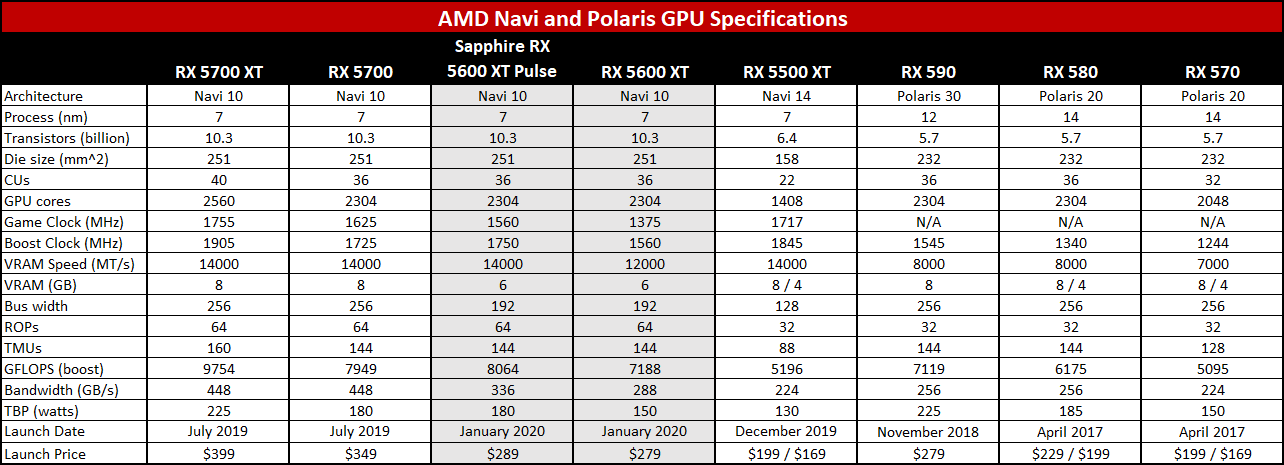
As far as the core hardware, the RX 5600 XT plays it straight. This is the same GPU as the RX 5700 (ie, Navi 10), but with 6GB GDDR6 instead of 8GB. It has the same 2,304 GPU cores, but with potentially lower clockspeeds. There are no 'reference' RX 5600 XT cards, however, which means most GPUs will be factory overclocked. I've included specs for both the baseline RX 5600 XT, as well as the Sapphire RX 5600 XT Pulse I'm using for this review.
The Sapphire card has much higher clockspeeds than the reference RX 5600 XT, on both the GPU core and GDDR6. That's after the VBIOS update that several places reported on last week, which increased performance by around 10 percent while also increasing power use. Officially, the TDP of the reference model is 150W, and the 'performance' BIOS for the Sapphire Pulse has a 180W TDP. Alternatively, there's a 'quiet' VBIOS that drops the TDP to 130W with lower clocks. In practice, the power use with the high performance BIOS fell well short of 180W during gaming tests, though perhaps some workloads will push it higher.
I've covered AMD's Navi / RDNA architecture before, and since this is the same Navi 10 GPU just with two of the GDDR6 chips removed, there's not much to say. Navi is AMD's first 'real' 7nm GPU—the Radeon VII doesn't count in my book, as it was overpriced and despite having 16GB of HBM2 never really performed as well as I'd like. It was a short-lived technology showcase for AMD, and as soon as the RX 5700 cards arrived it faded away. The problem is that AMD is still missing a direct answer to Nvidia's ray tracing capable RTX series hardware, which will likely come later this year (Navi 20 or Navi 21) as a high-end offering to compete with the likes of the RTX 2080 Super. Until then, the RX 5600 XT is supposed to fill the gap between the RX 5500 XT and RX 5700. Except…
Zooming out from the RX 5600 XT, the graphics card market is filled with various cards at different price points, some of which land awfully close together. The GTX 1660 Super and 1660 Ti for example offer very similar performance, with the Super mostly costing $40 less. At this point, the 1660 Ti is superfluous—especially with the RTX 2060 nominally available for just $299. That same sort of logic can be applied to the RX 5600 XT. At $279 it performs quite well and easily eclipses the GTX 1660 Ti and Super cards. The competition with the RTX 2060 is far closer, but the real difficulty is that AMD's own RX 5700 is frequently on sale for $299, and starts at $310 at the time of writing. The Sapphire card I'm using for this review costs $289, so $20 more for the extra VRAM on the RX 5700 makes a lot of sense.
Ultimately, even before we hit the performance charts, it feels like the RX 5600 XT is priced a bit too high relative to the RX 5700. I won't be surprised if the street pricing on these cards starts high and then eventually drops closer to $250. Regardless, the mainstream $200-$300 price bracket is very congested—there are many options, including previous generation GPUs that are still floating around (eg, Vega 56, RX 590, etc).
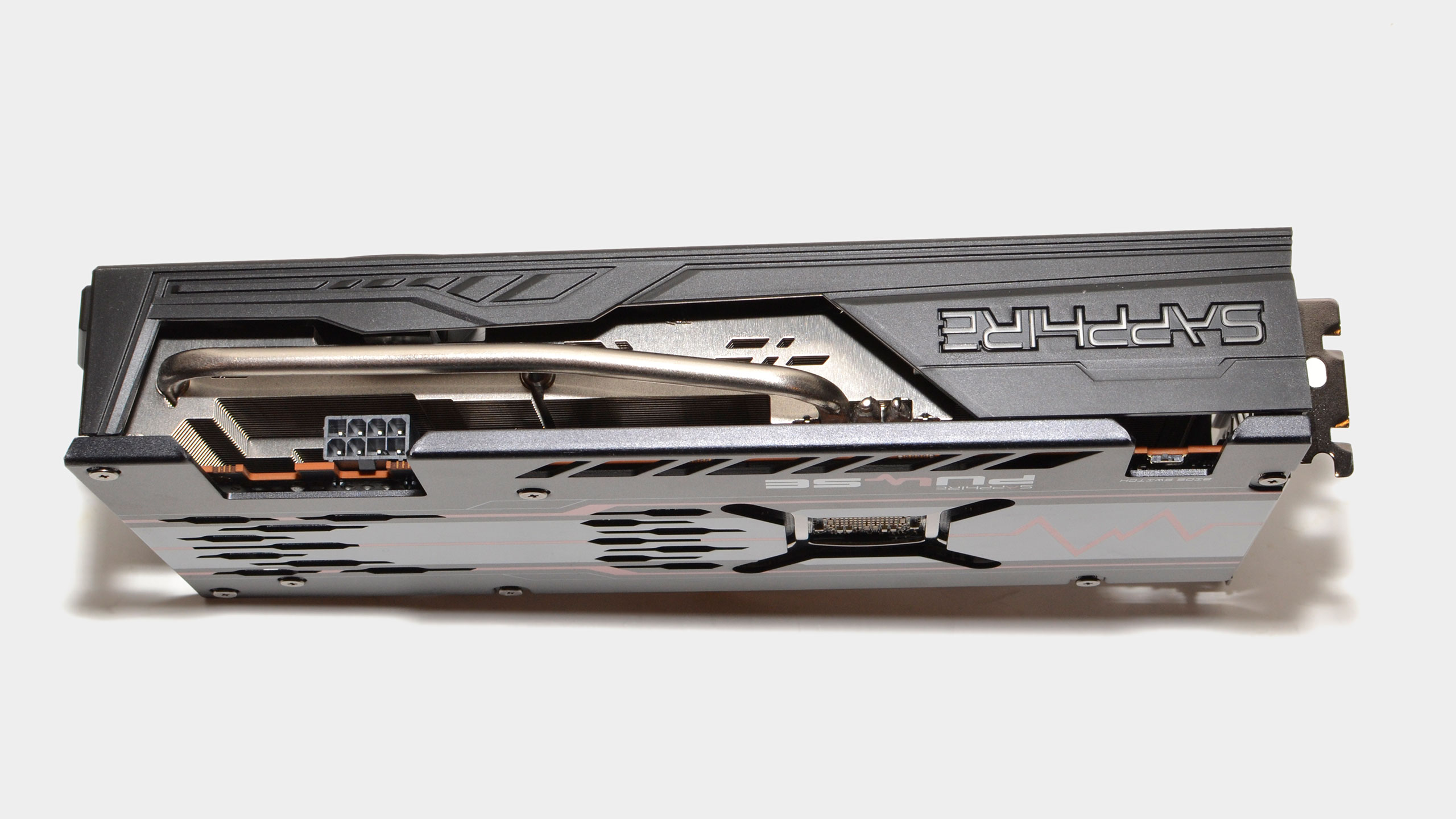
Radeon RX 5600 XT gaming performance
I've been busily retesting a bunch of graphics cards with the latest drivers, OS updates, and a slightly modified test bed. My previous testbed used an overclocked Core i7-8700K running at 5.0GHz, but I'm switching to an updated build with a Core i9-9900K (still overclocked to 5GHz)—just to be safe. It won't really affect performance on the budget and mid-range cards, but the fastest GPUs can benefit somewhat from the shift to the i9-9900K (or i9-9900KS if you can find one at a reasonable price). The goal is to show the maximum performance possible from the various graphics cards, by removing other bottlenecks as much as possible.
Note: Not all of the GPU results in the charts are updated, as I haven't had time to fully retest all the previous generation cards. All the current Nvidia Turing (RTX and GTX 16-series) and AMD RX 5000 series GPUs are up to date, and performance is typically 3-5 percent higher than older drivers on the cards I've checked. The RX 590 and RX 570 results are also up to date, while the Vega, RX 580, and GTX 10-series cards use legacy results (but should be okay as a rough point of reference).
Testing is done at 1080p 'medium' and 'ultra' settings (which may go by different names, depending on the game—details are in the chart subtitles), as well as 1440p and 4K at 'ultra' settings. I've also added Red Dead Redemption 2 to the suite of games I'm testing, bringing things to an even dozen. Each game is tested multiple times to ensure consistency of performance.
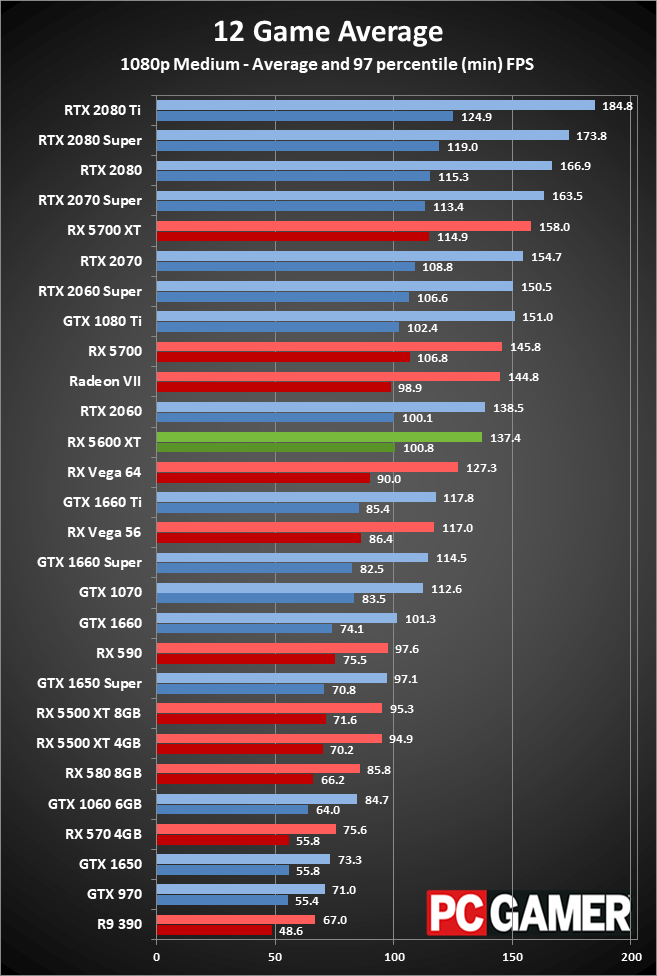
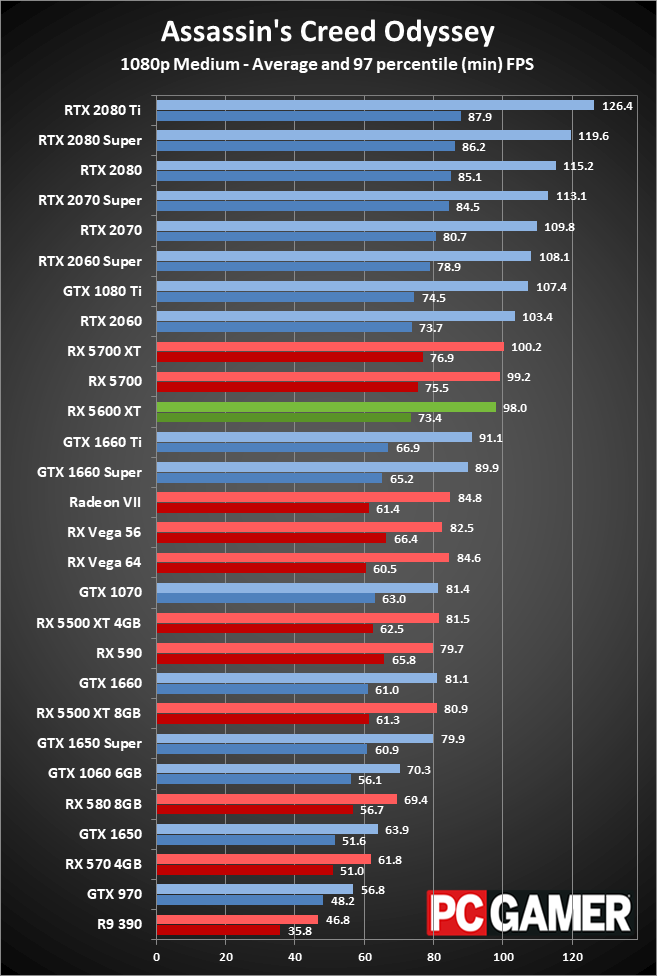
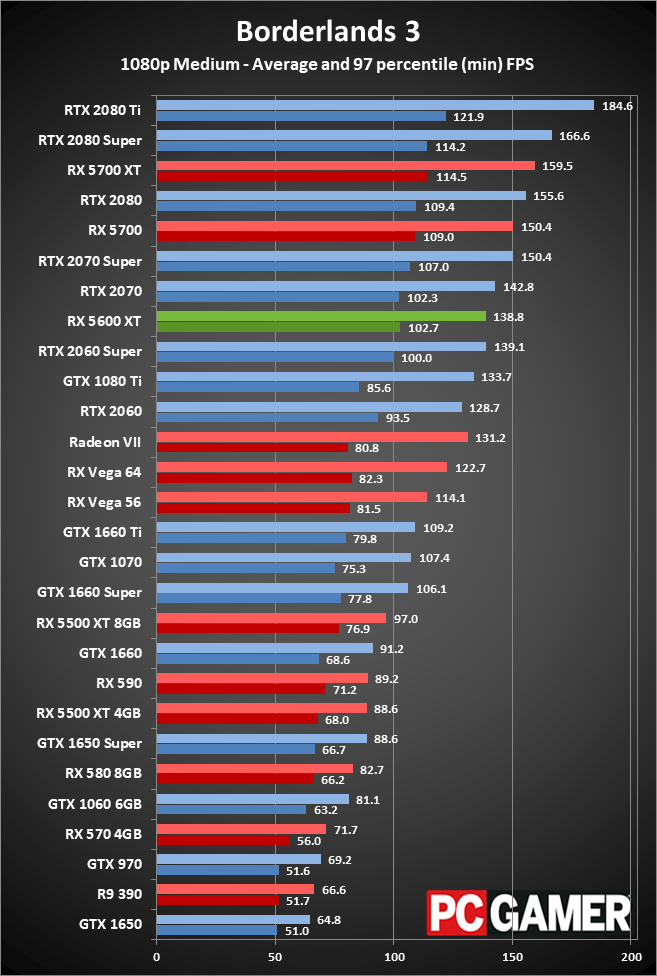
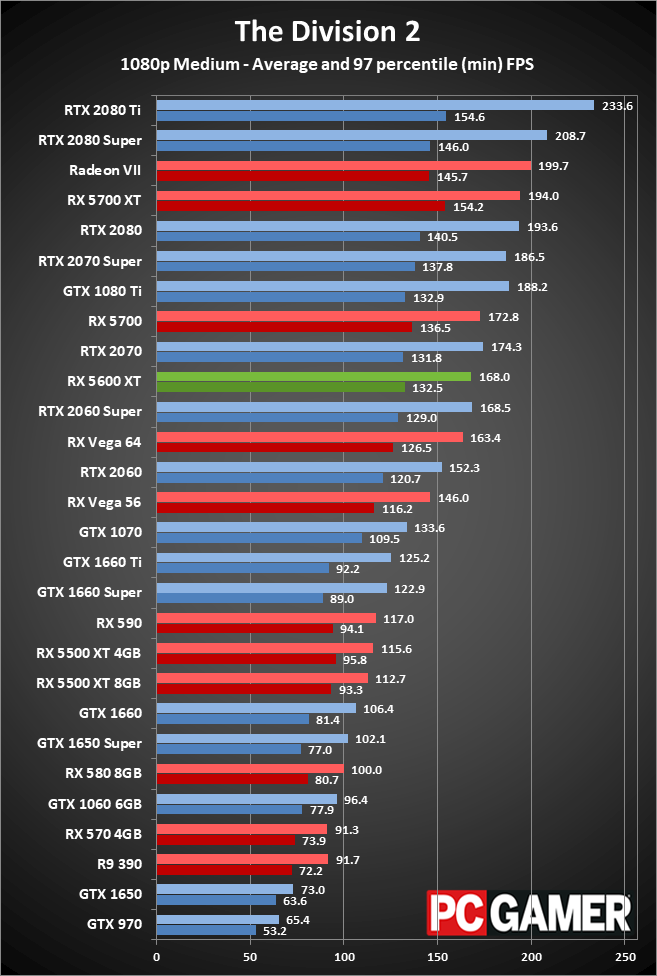
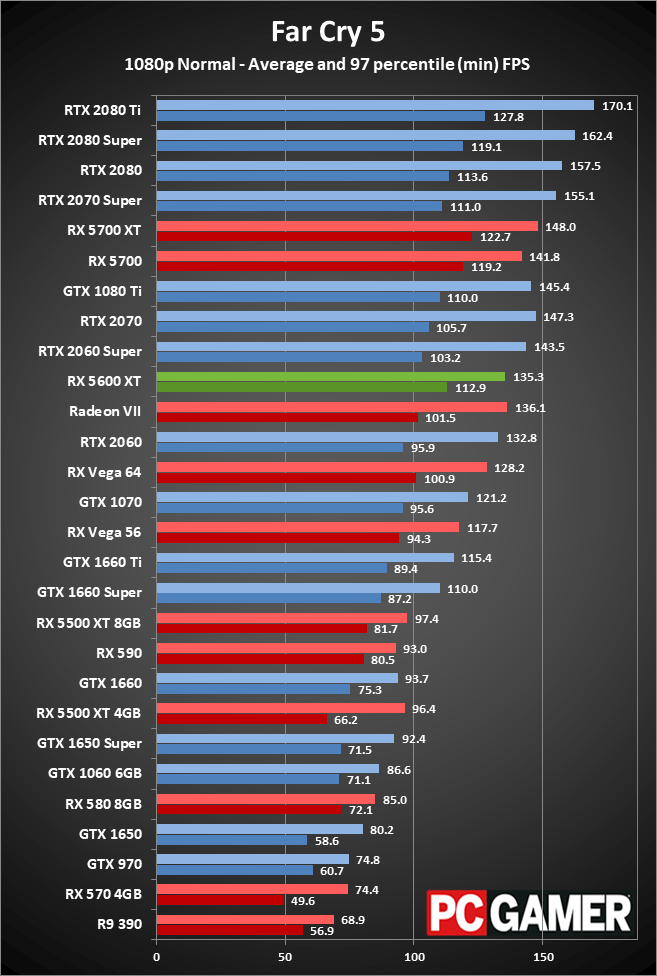
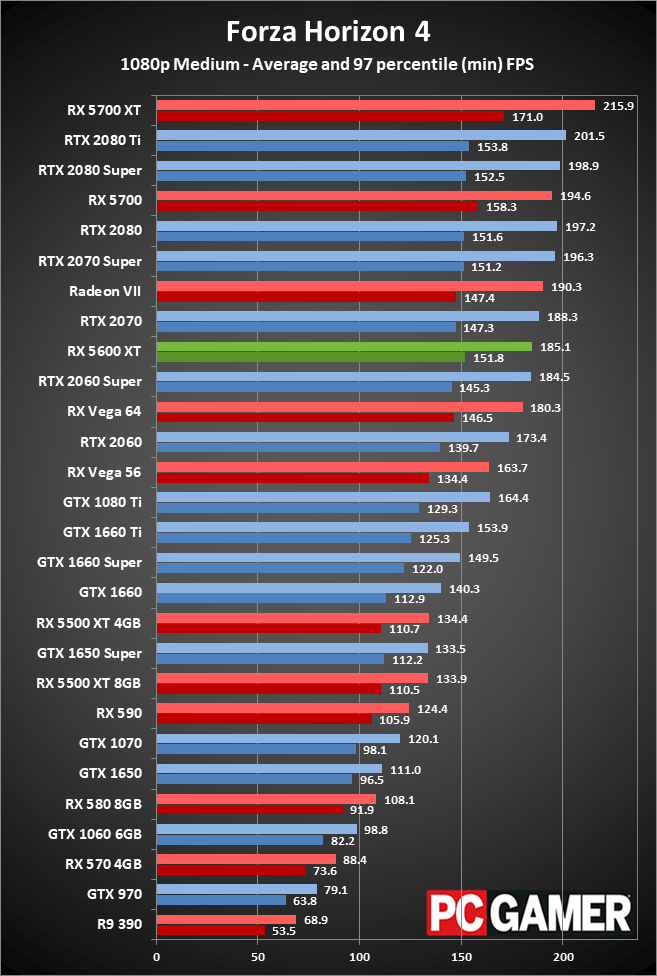
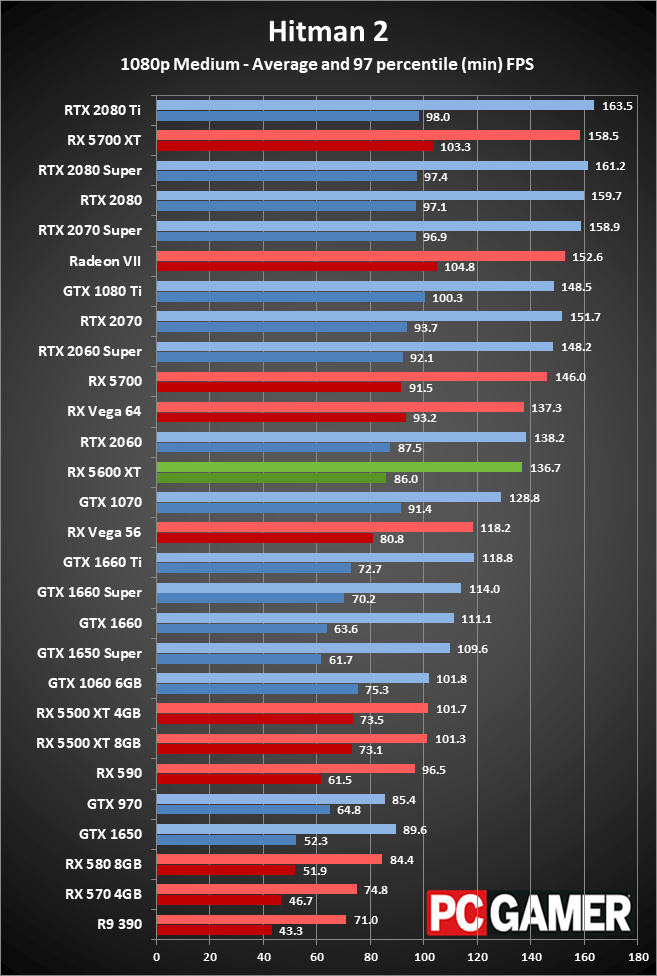
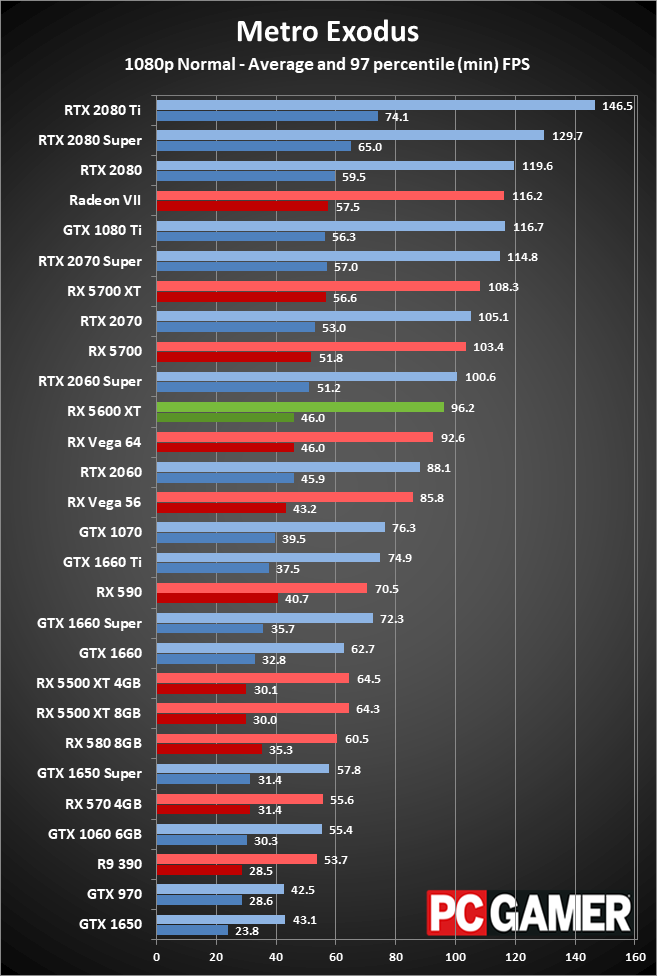
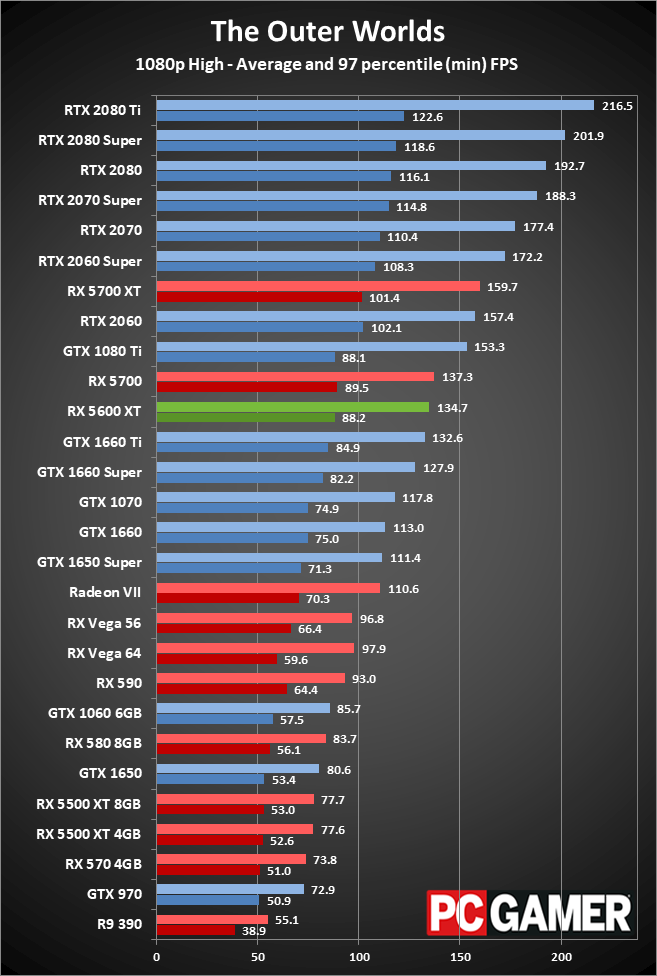
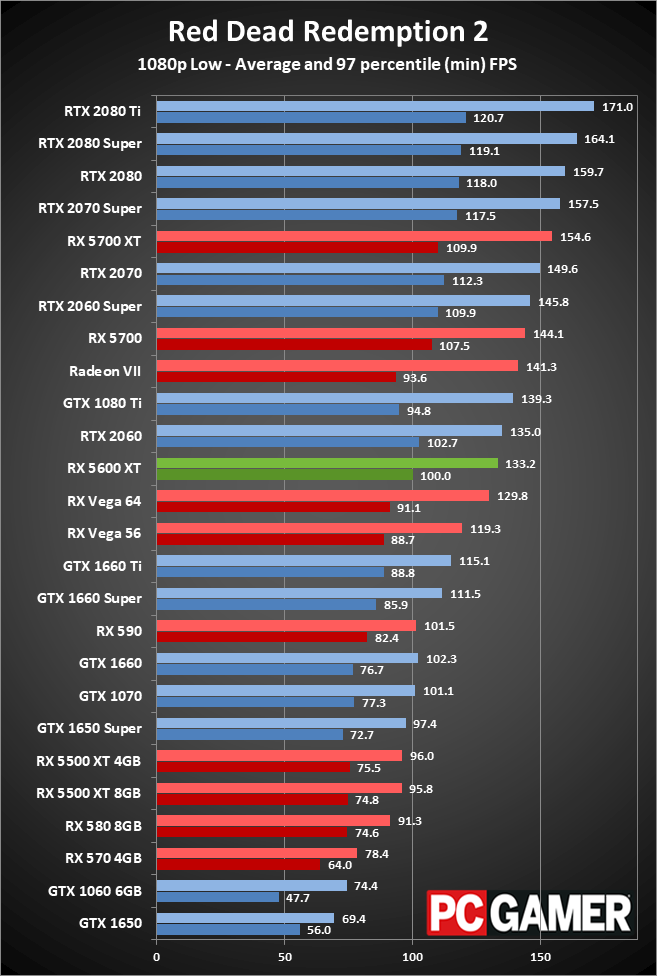
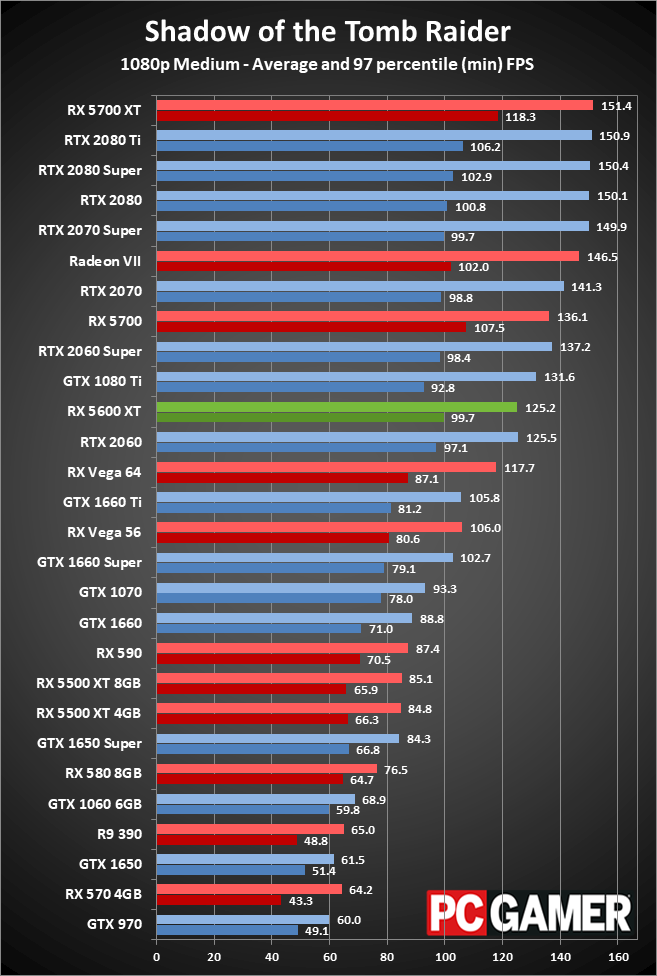
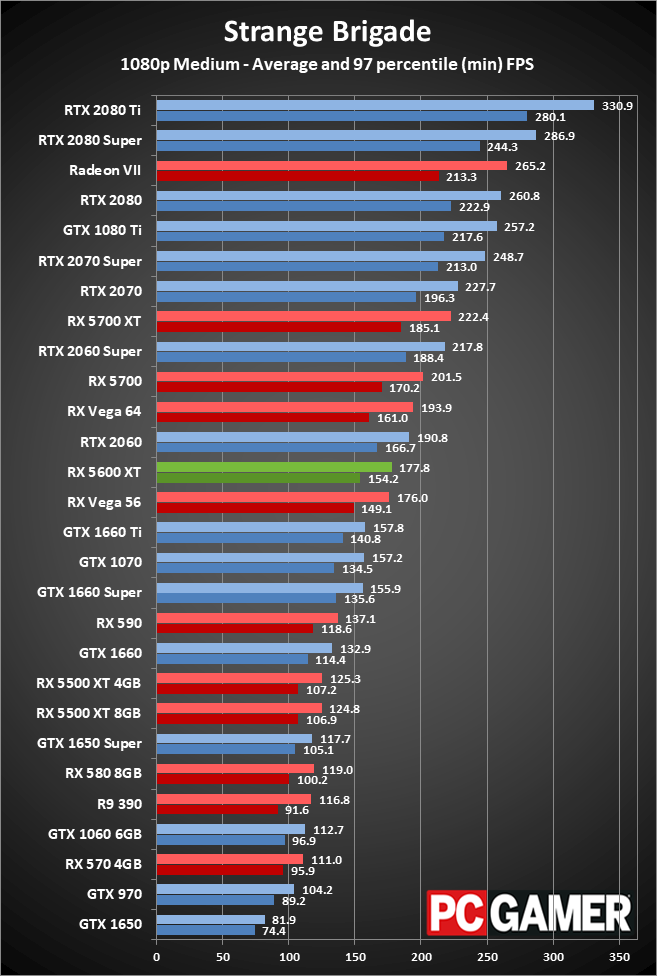
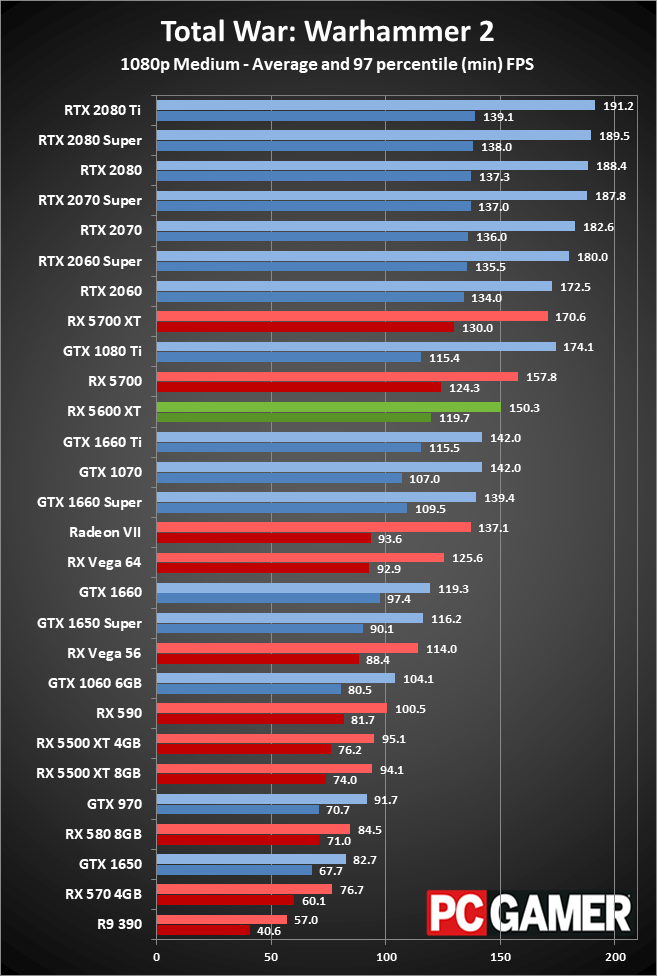
1080p medium is an easy hurdle for the RX 5600 XT, with average framerates of around 137 fps across the 12 tested games. Only the two most demanding games, Assassin's Creed Odyssey and Metro Exodus, fall below 100 fps. If you're mostly looking at esports games, framerates would be even higher.
At these settings, the RX 5600 XT is 17 percent faster than the 1660 Ti, 20 percent faster than the 1660 Super, and 6 percent slower than the RX 5700. It's also 8 percent faster than the Vega 64, and 4 percent faster than the GTX 1080. For a $280 graphics card, that's a strong showing, though let's see how it fares at more demanding settings.
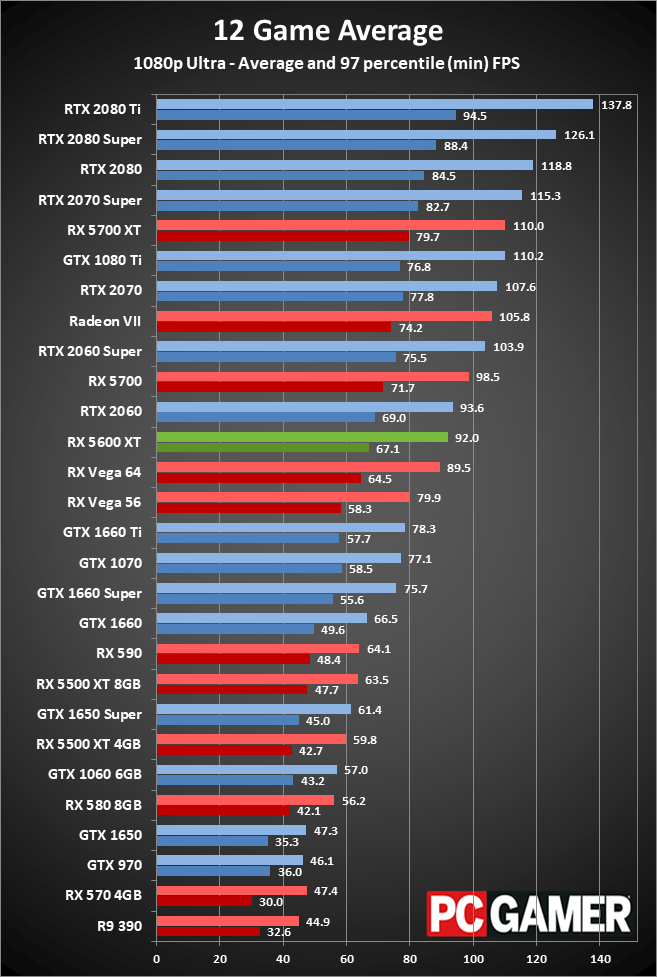
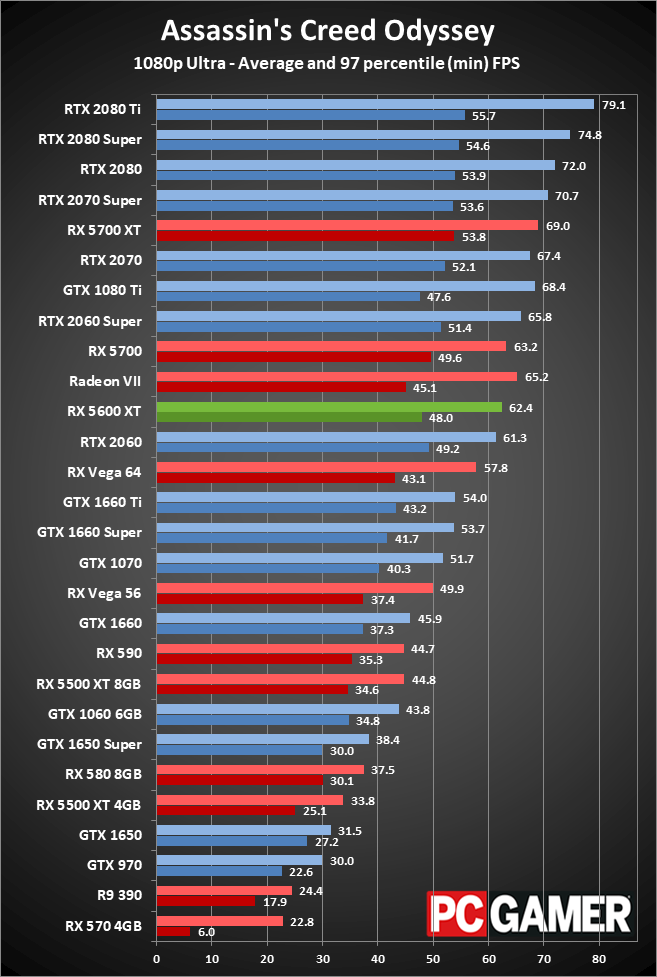
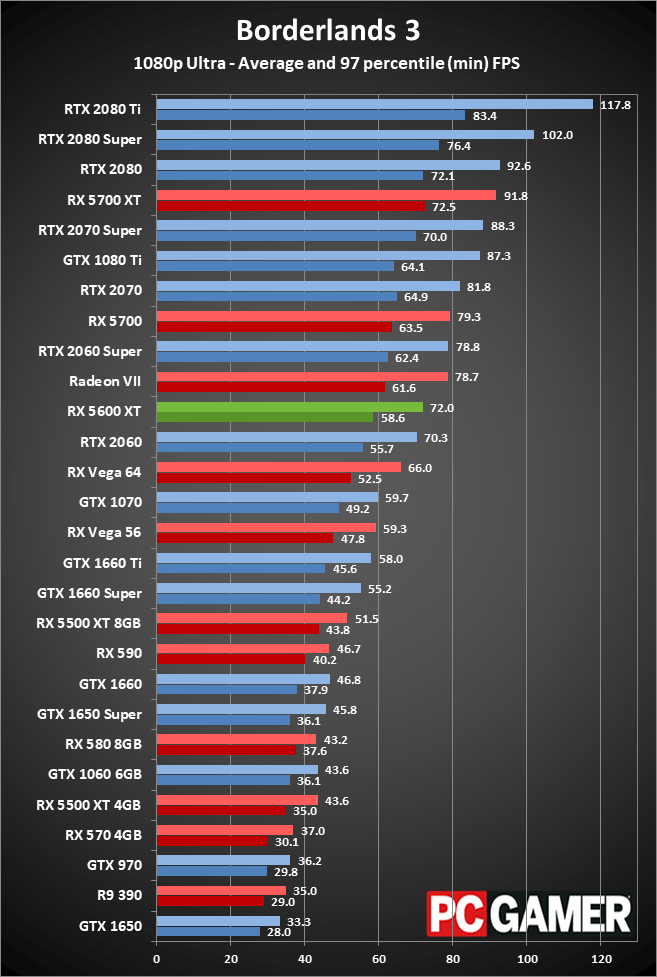
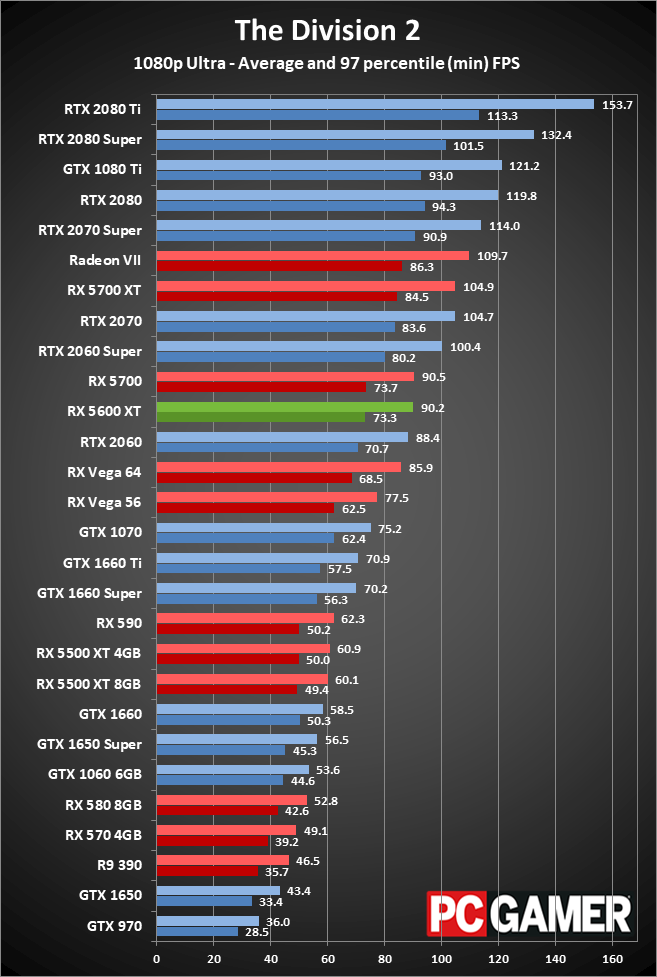
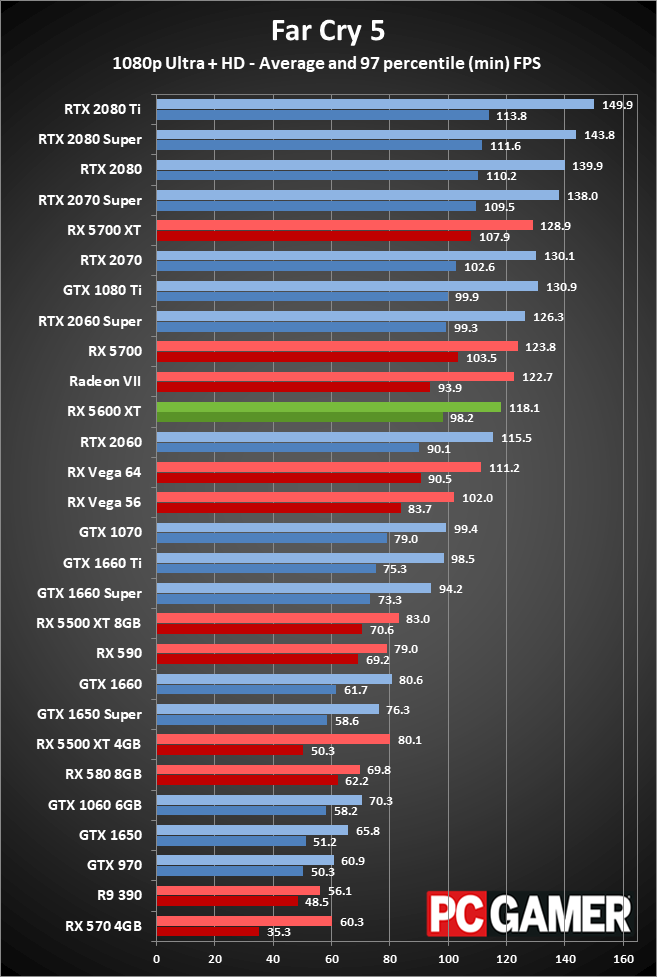
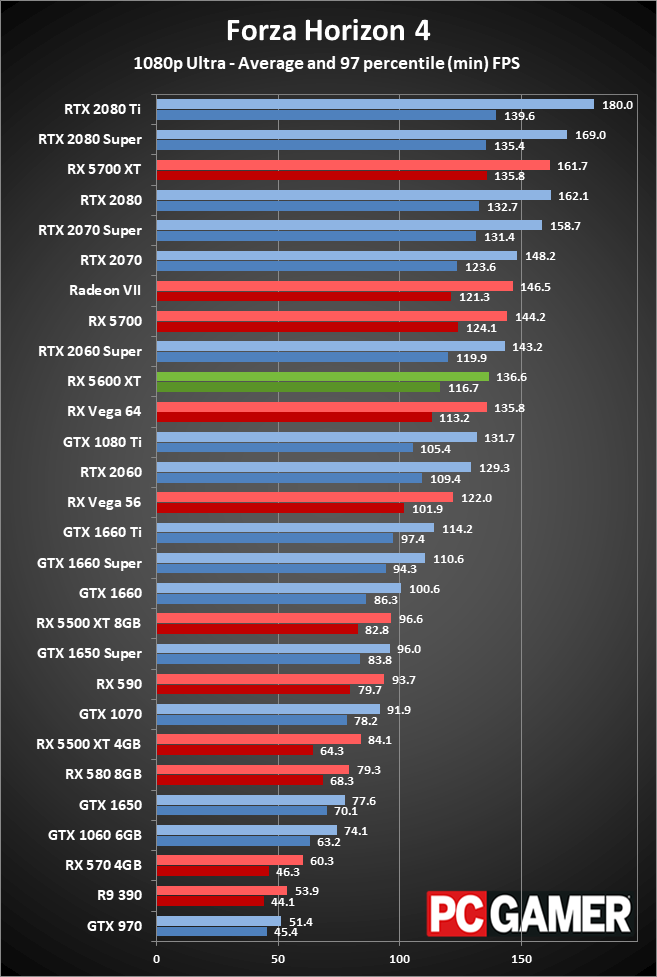
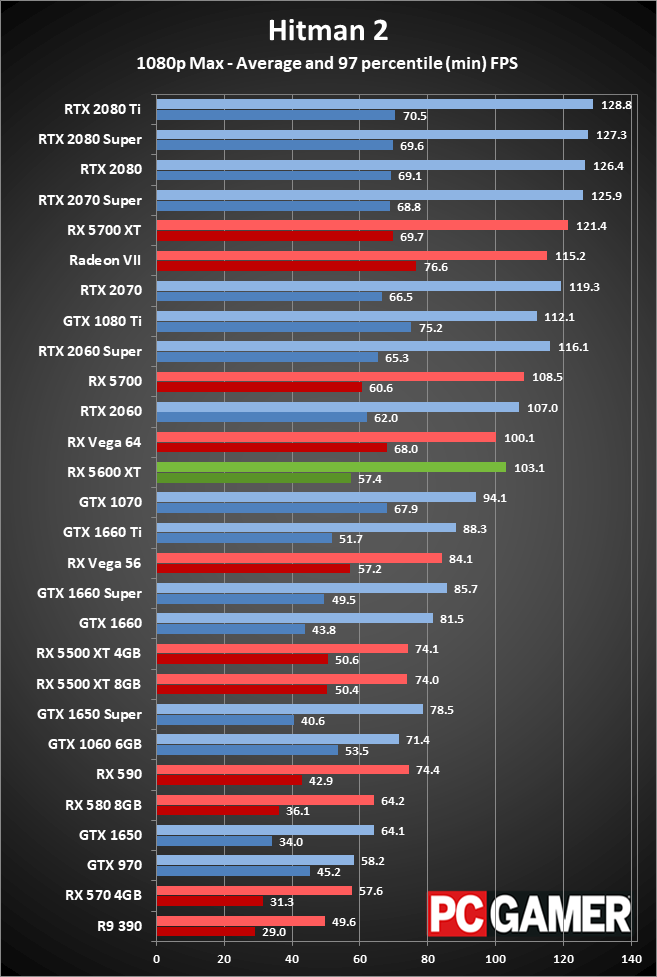
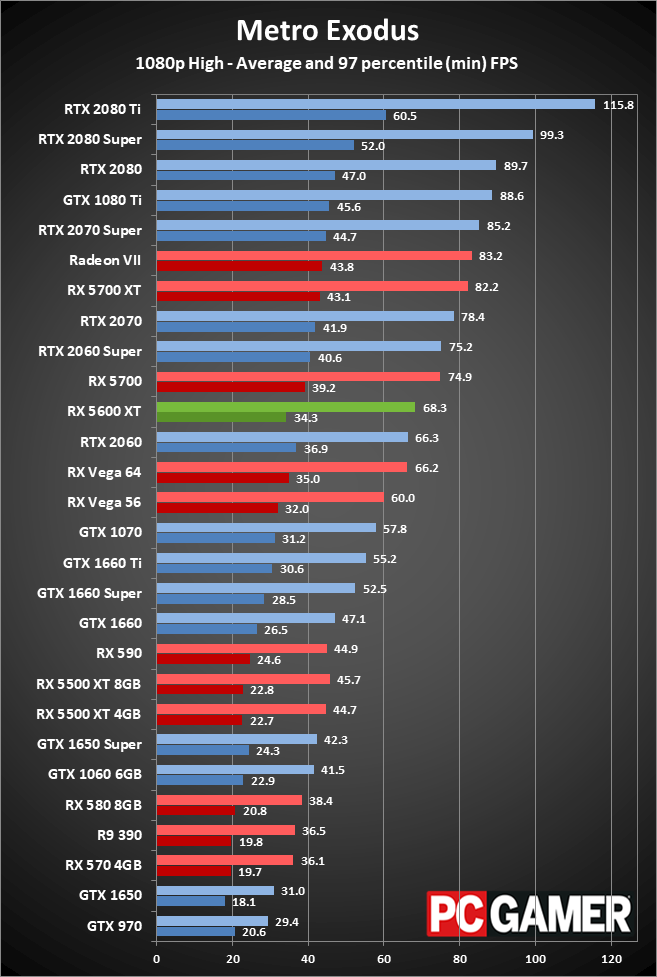
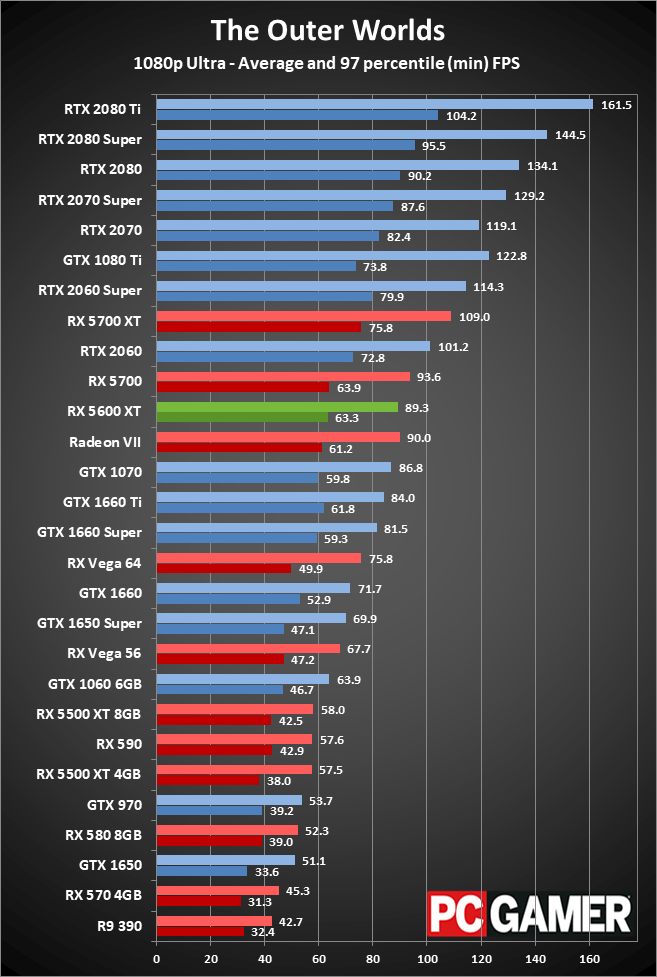
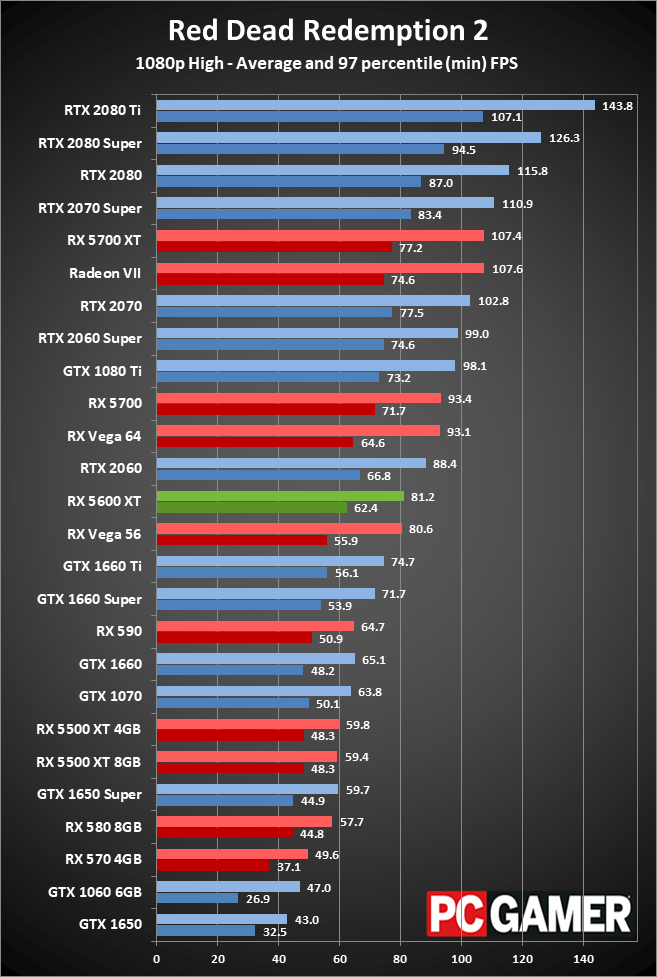
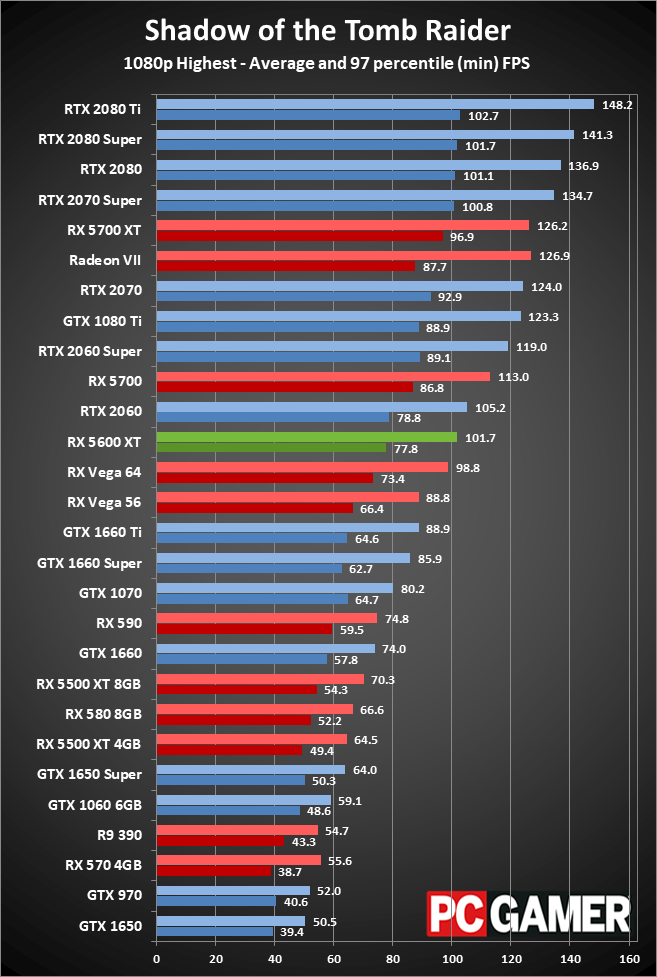
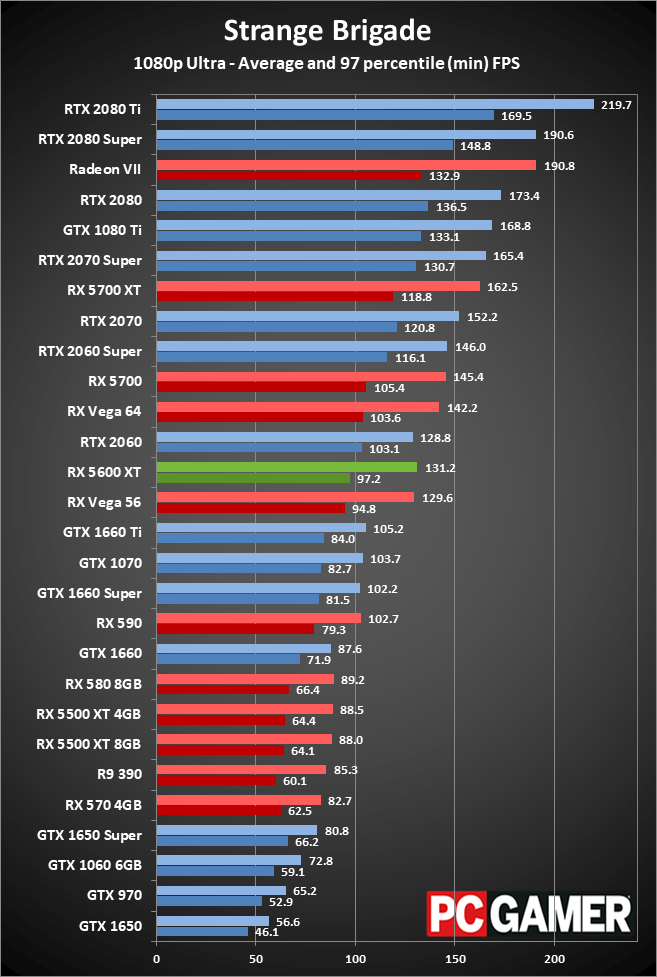
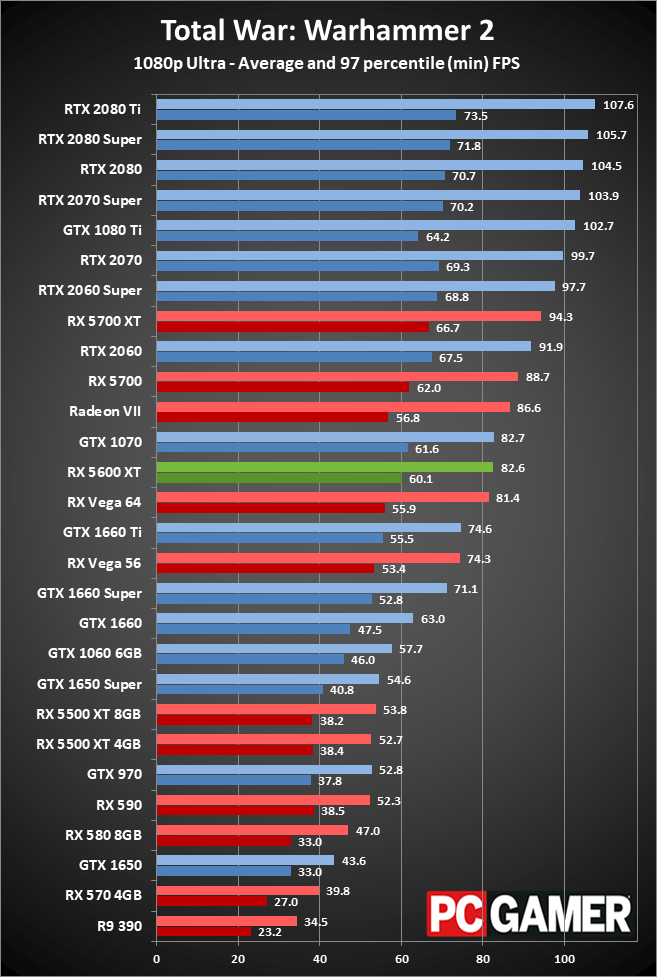
The 5600 XT is priced at the top of the mid-range GPU market, or the bottom of the high-end market. As such, it's important for it to perform well at 1080p ultra, and it does. All 12 of the test games still break 60 fps, with a composite average of 92 fps. Less demanding games won't be a problem.
The RX 5600 XT and RTX 2060 continue to trade blows—Assassin's Creed Odyssey, Borderlands 3, The Division 2, Far Cry 5, Forza Horizon 4, Metro Exodus, and Strange Brigade favor the 5600 XT by small amounts, while Hitman 2, The Outer Worlds, Red Dead 2, Shadow of the Tomb Raider, and Total War: Warhammer 2 go to the RTX 2060 by slightly larger amounts. Basically, it's a tie, with the 2060 holding a tiny 2 percent overall lead. As for the GTX 1660 Ti and GTX 1660 Super, they're no closer and actually fall a bit further behind.
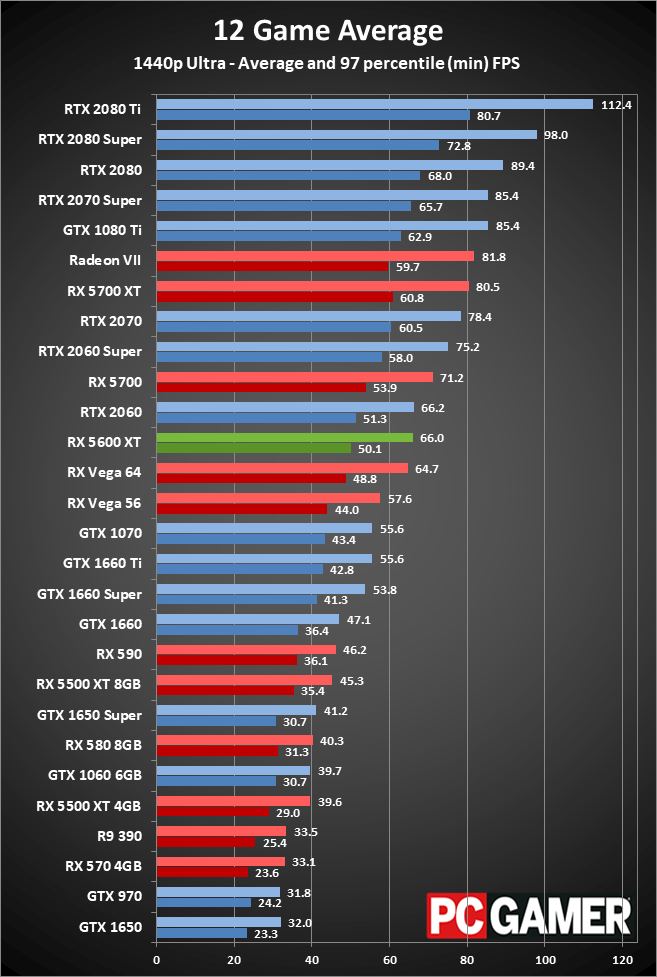
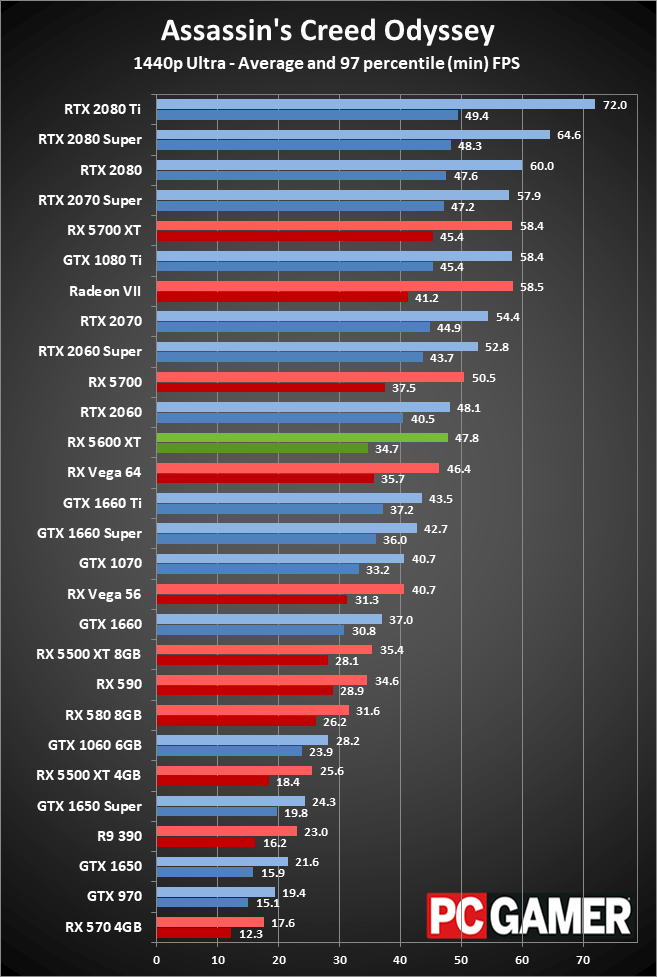
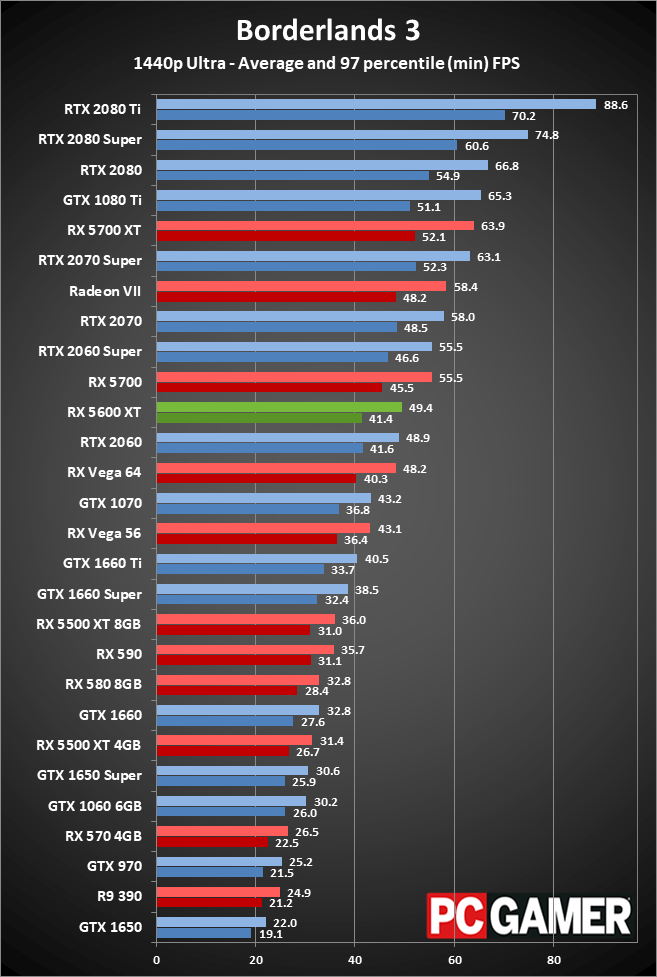
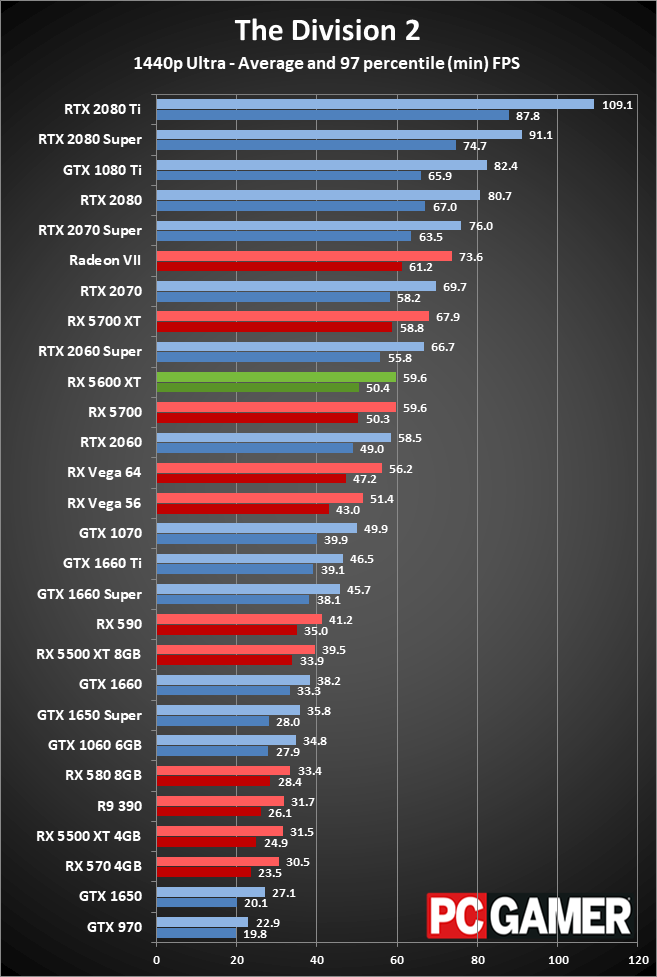
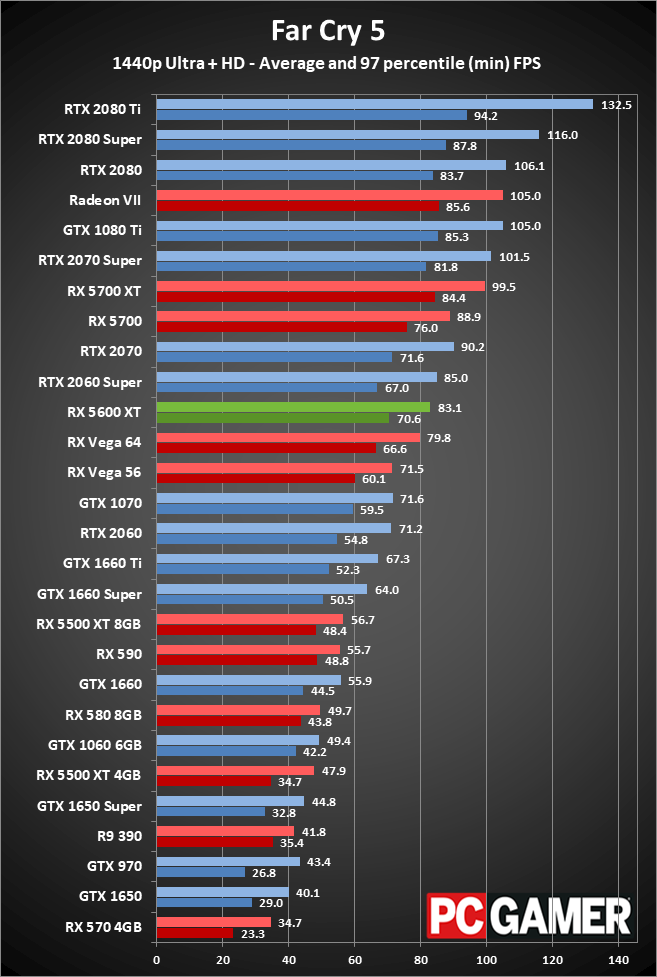
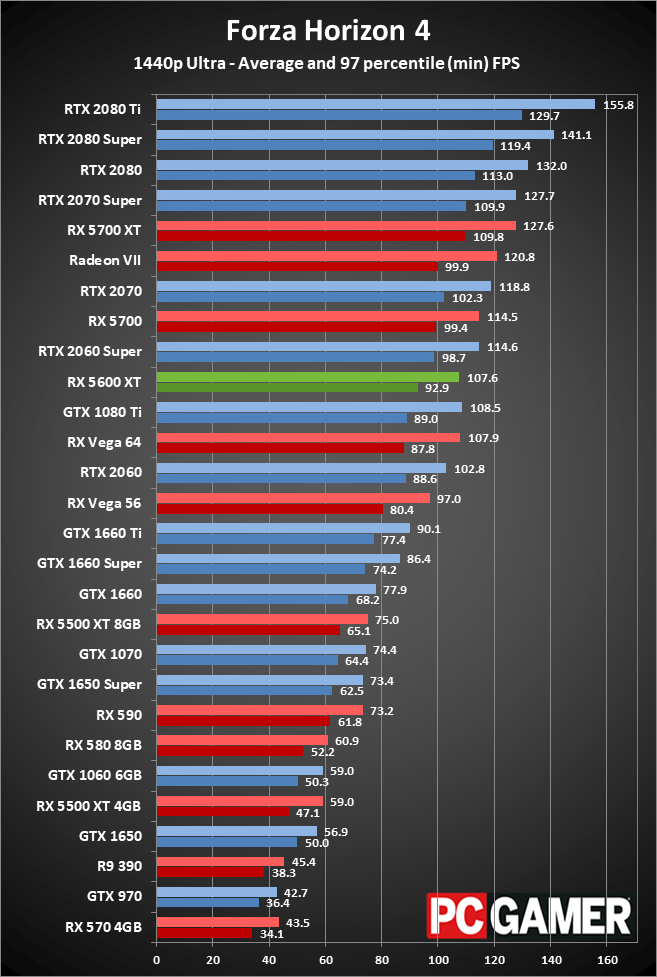
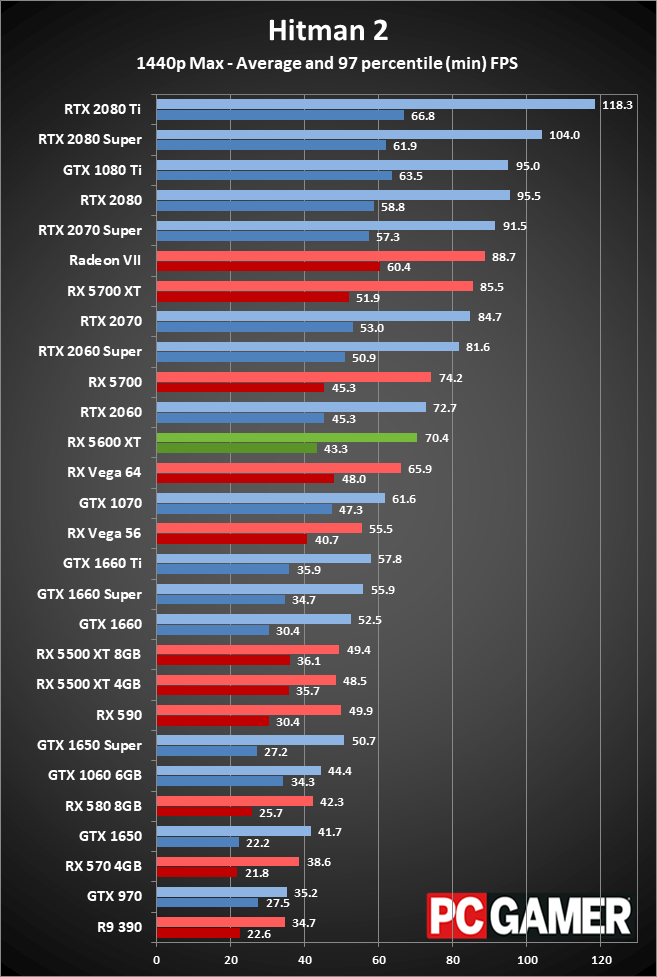
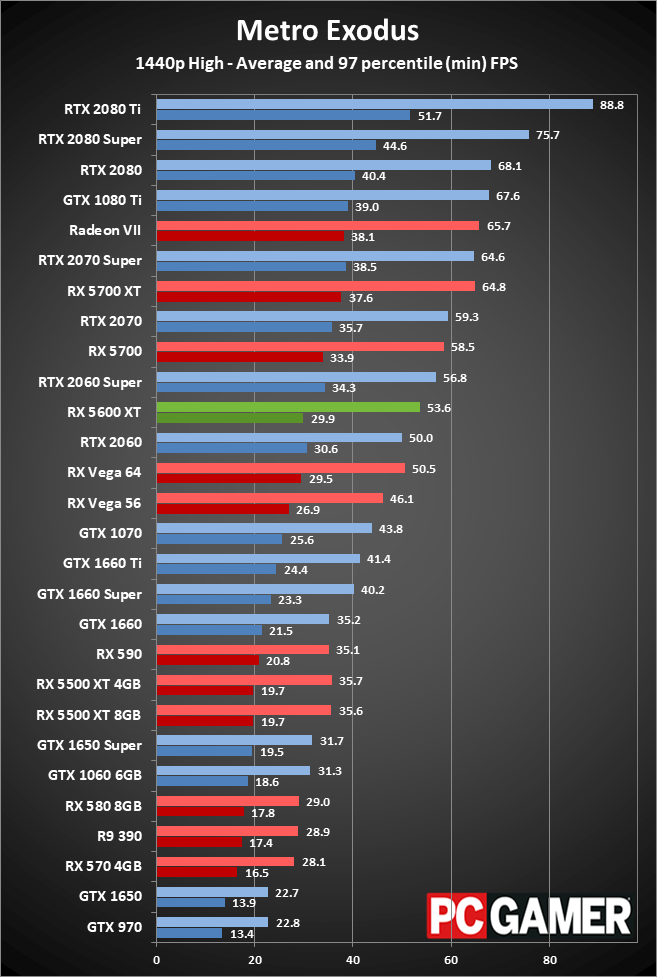
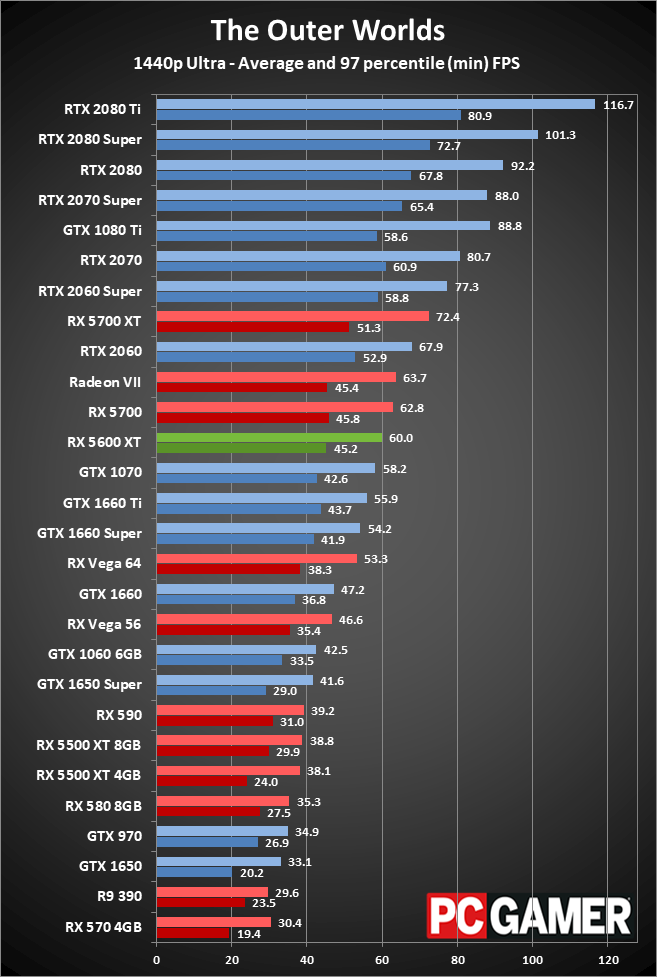
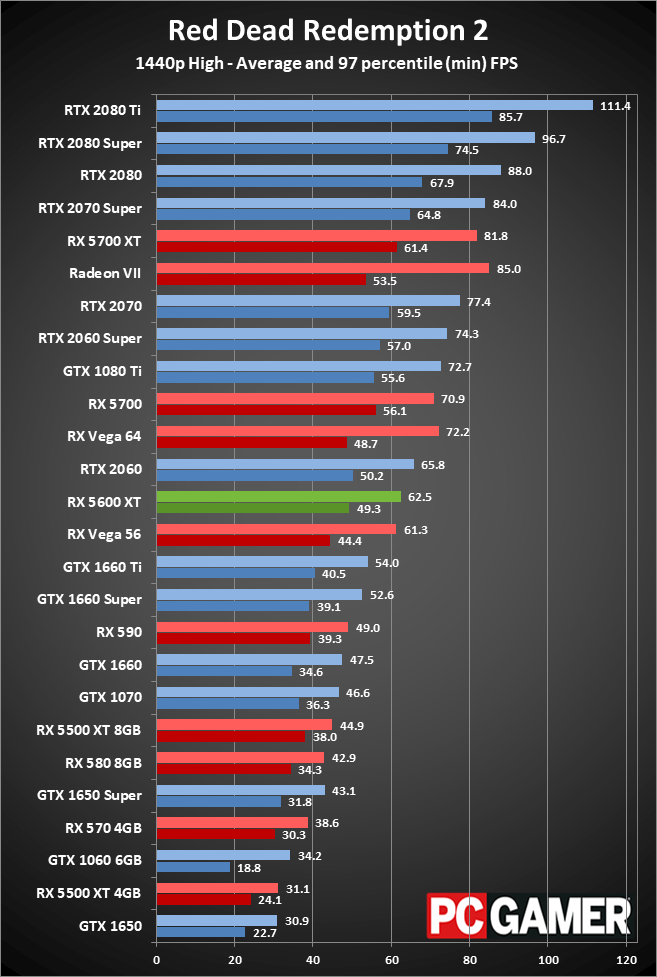
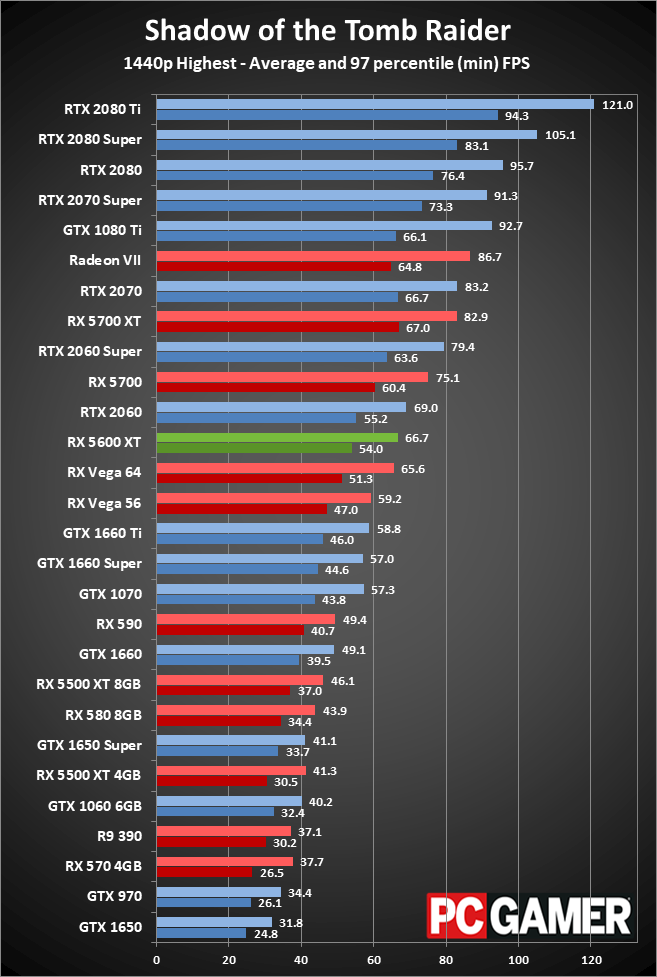
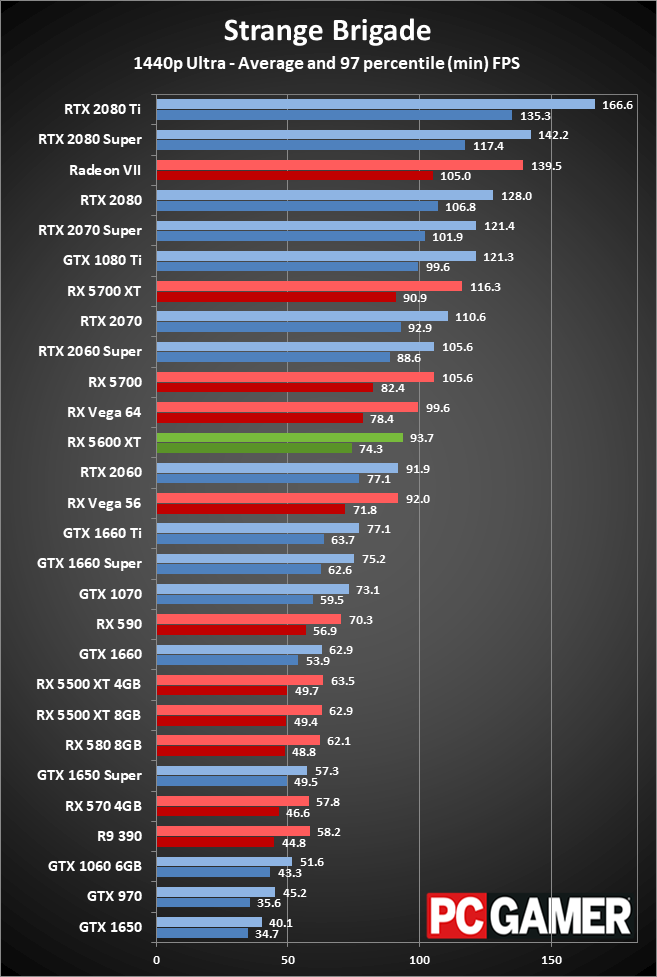
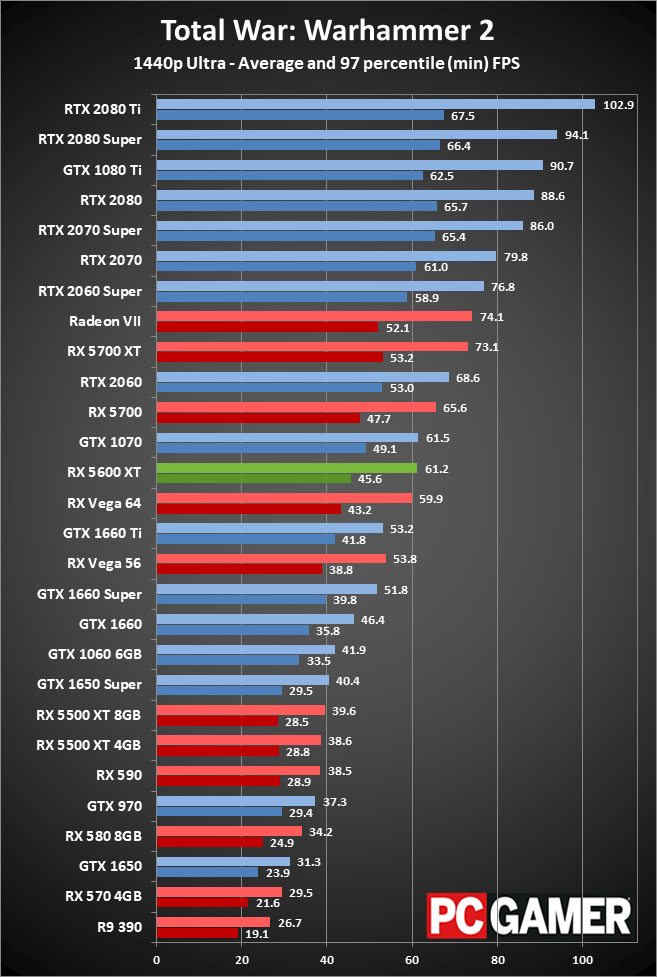
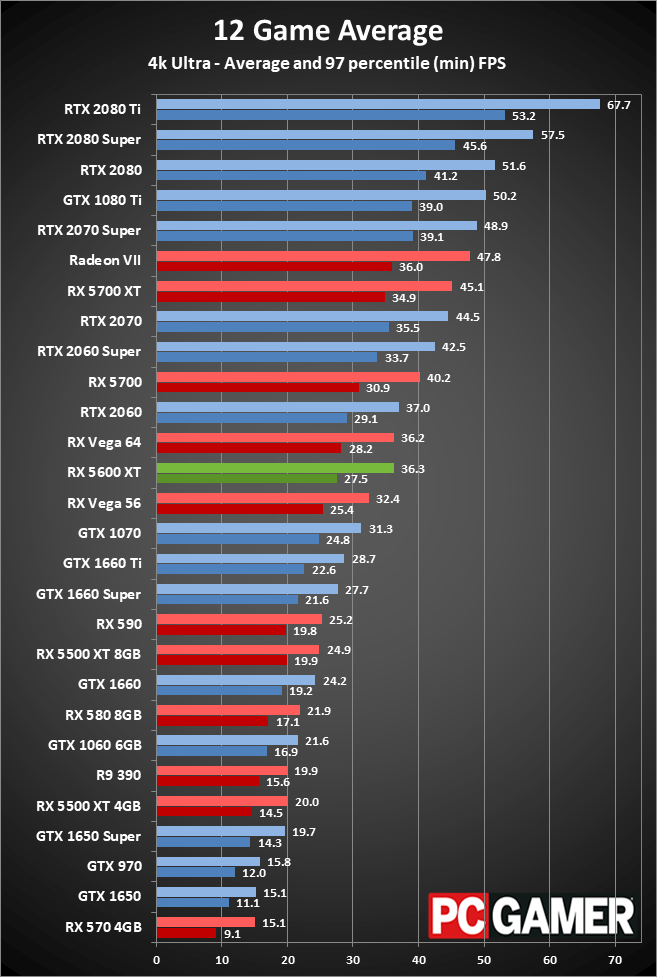
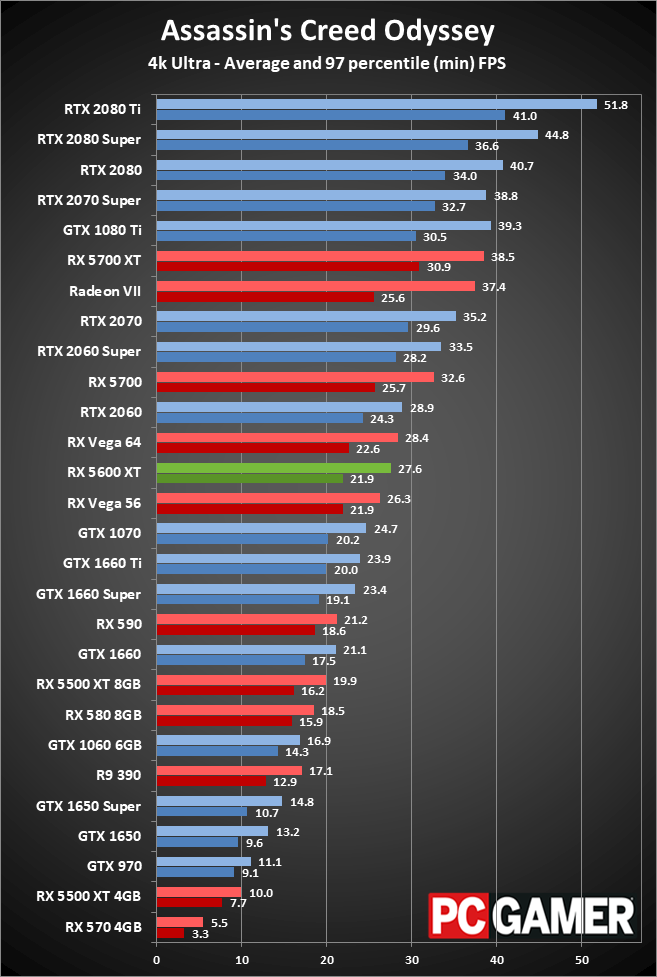
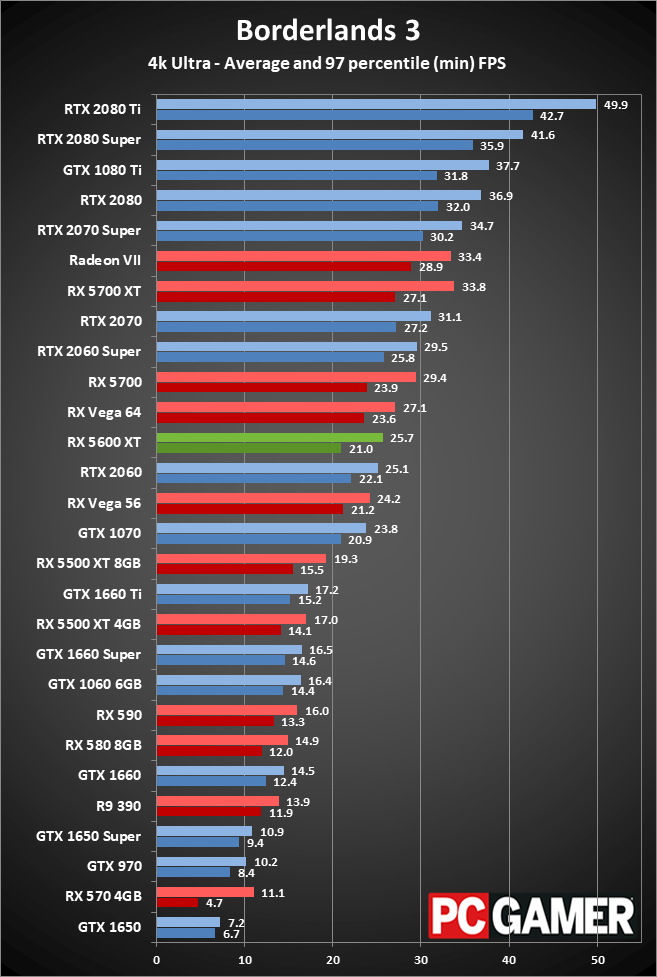
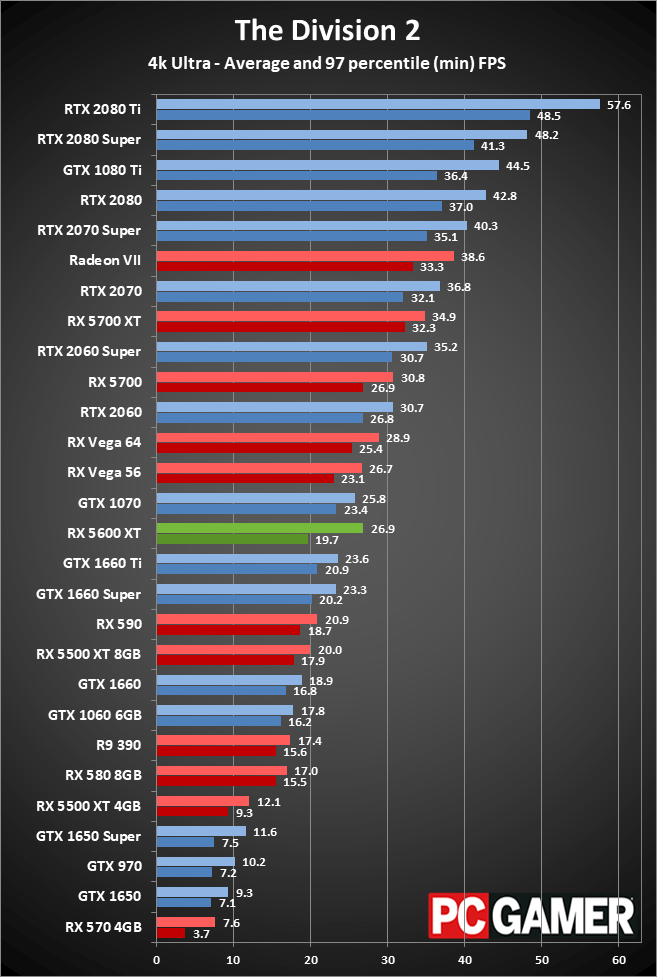
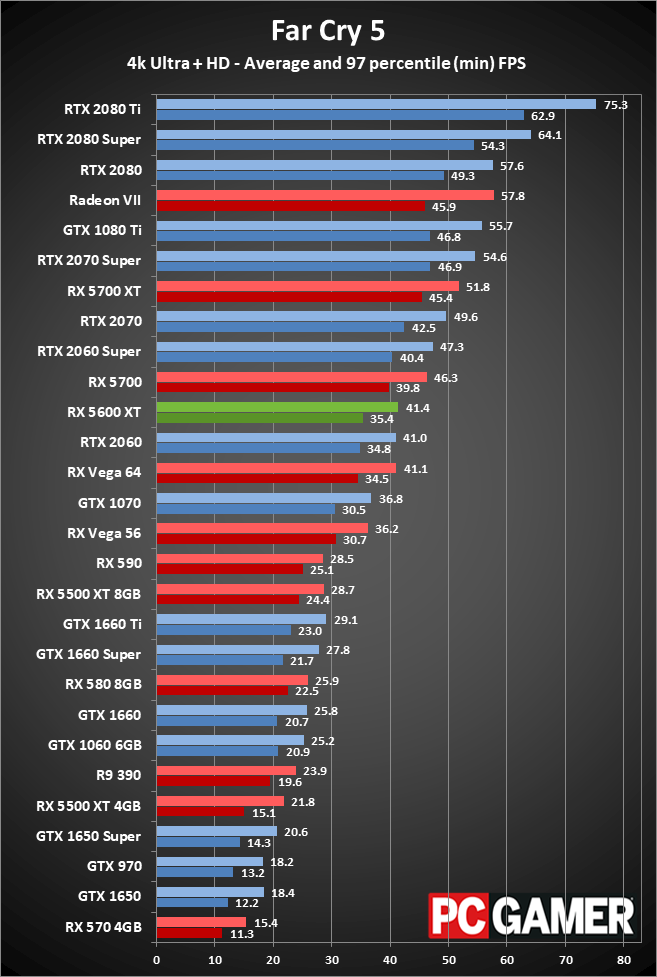
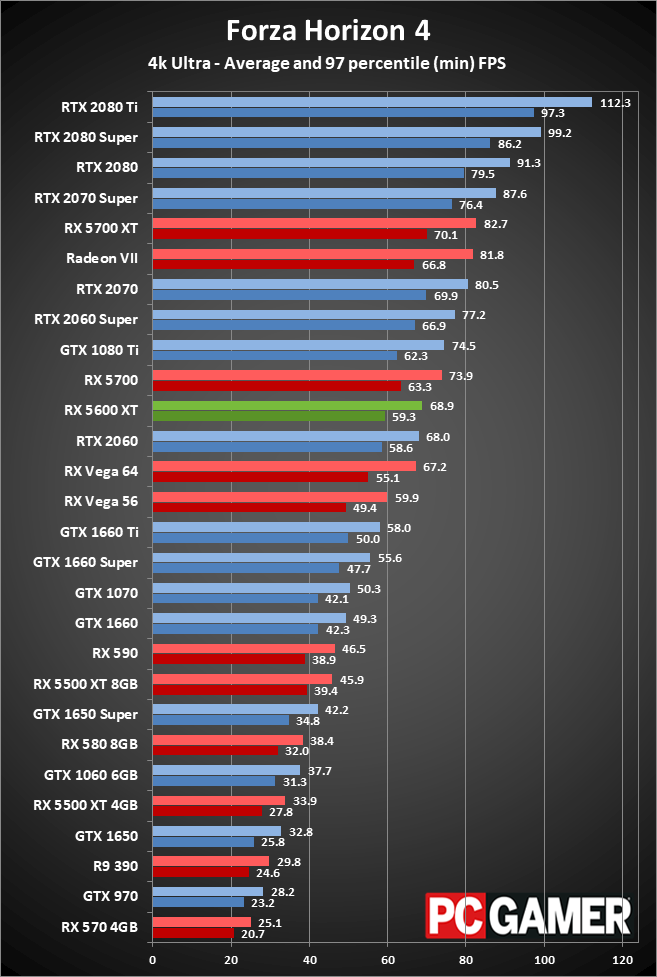
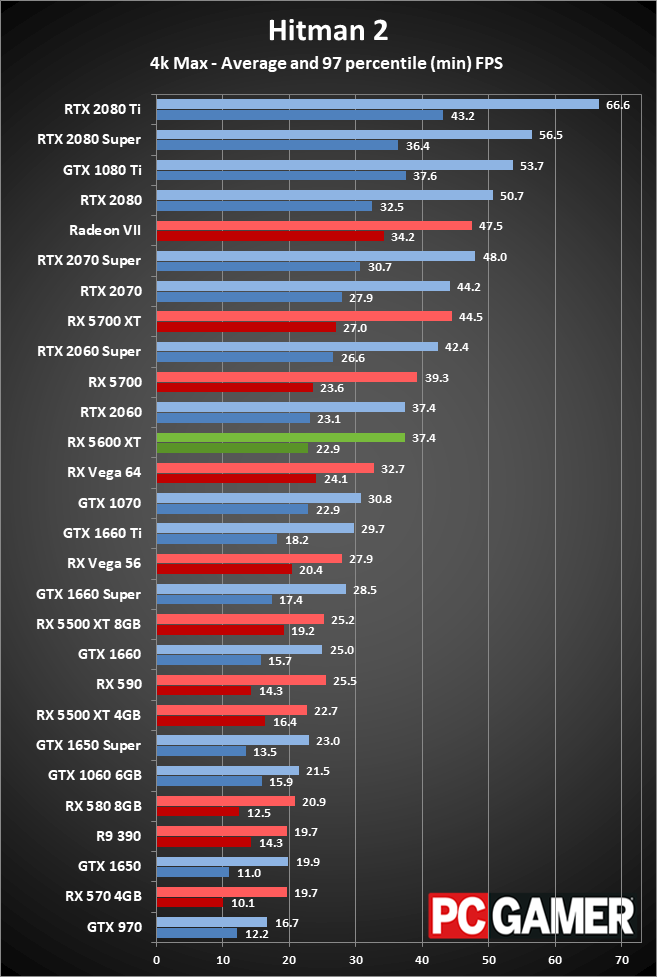
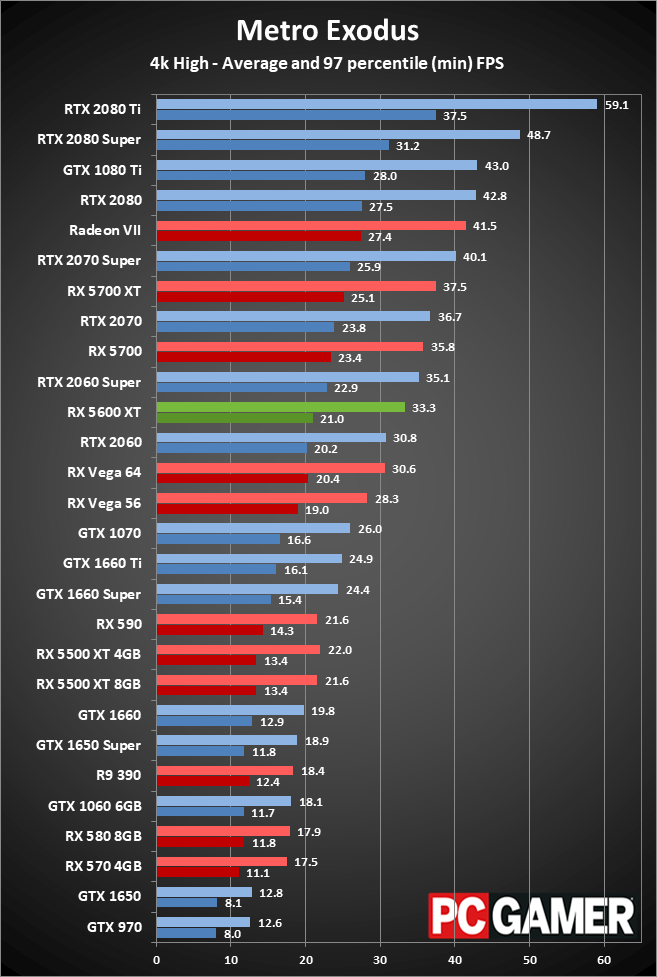
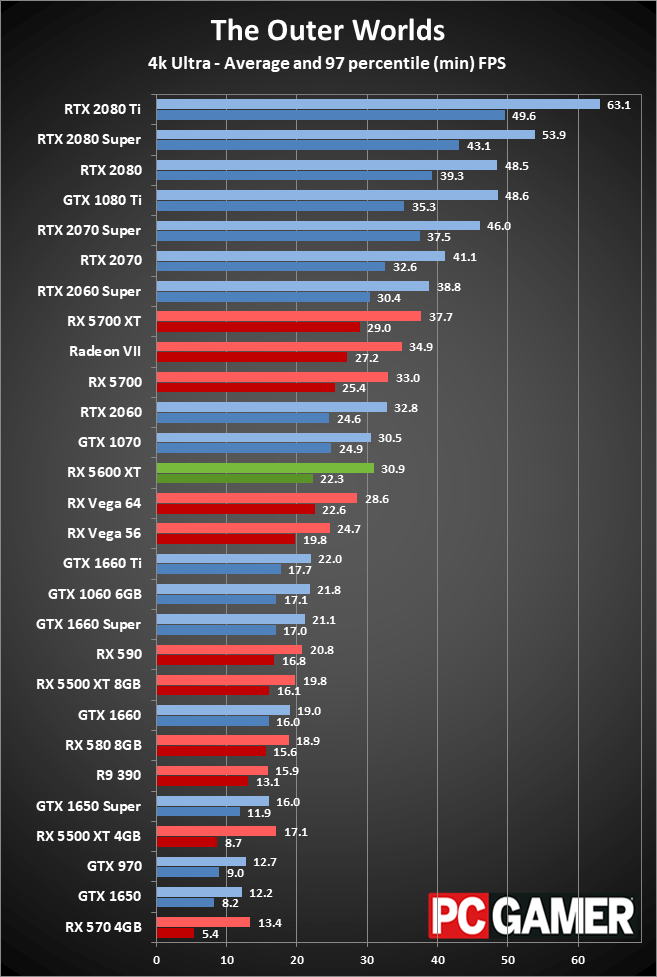
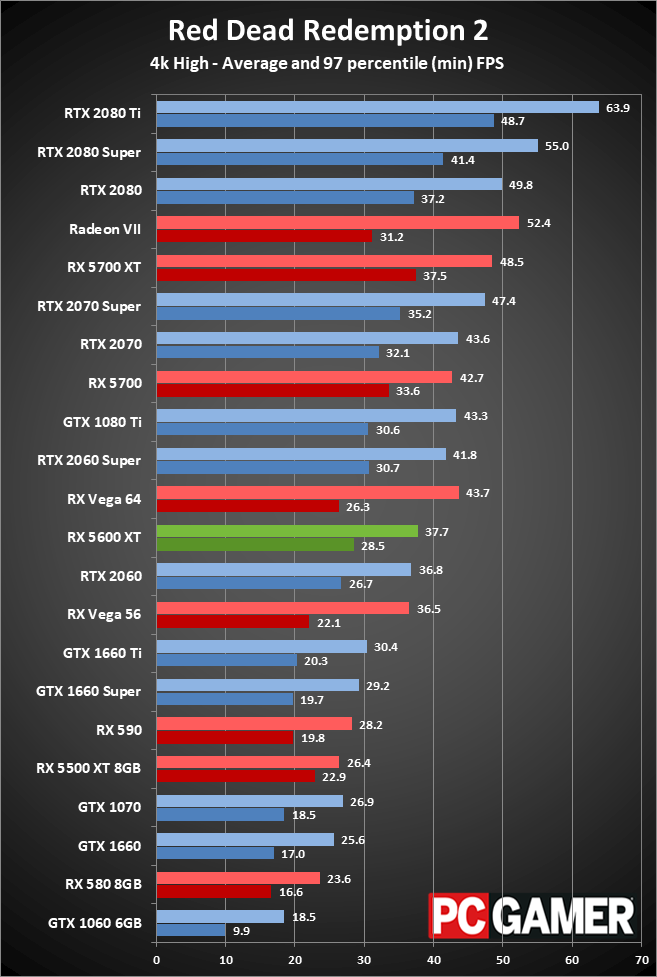
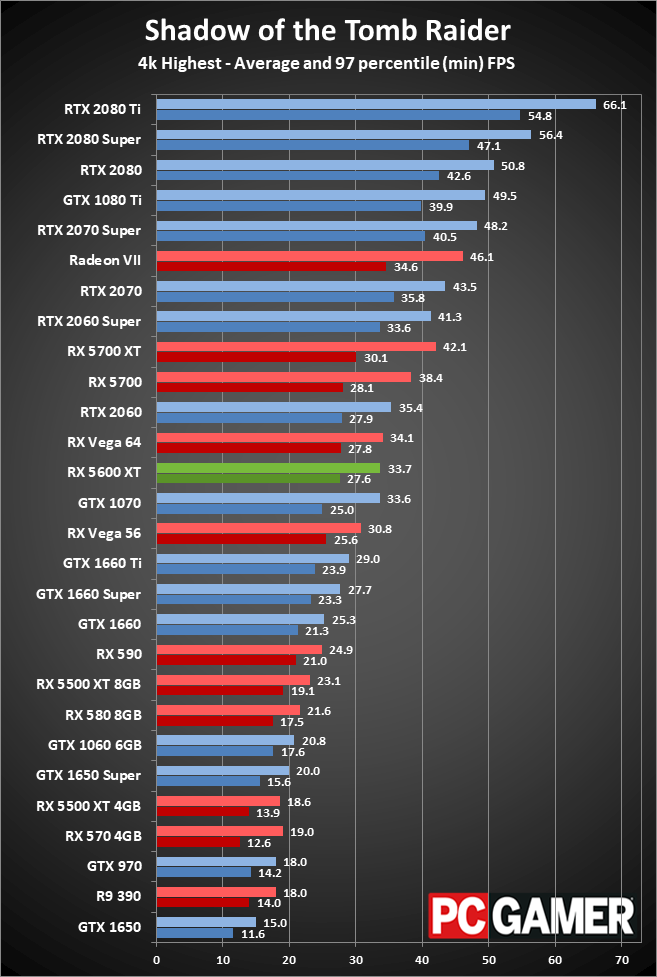
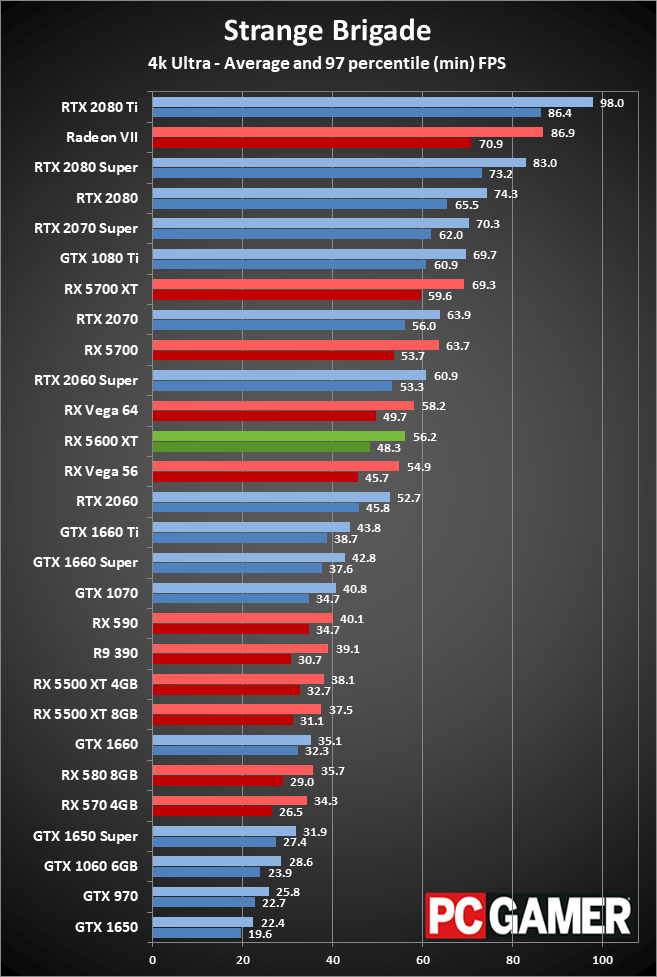
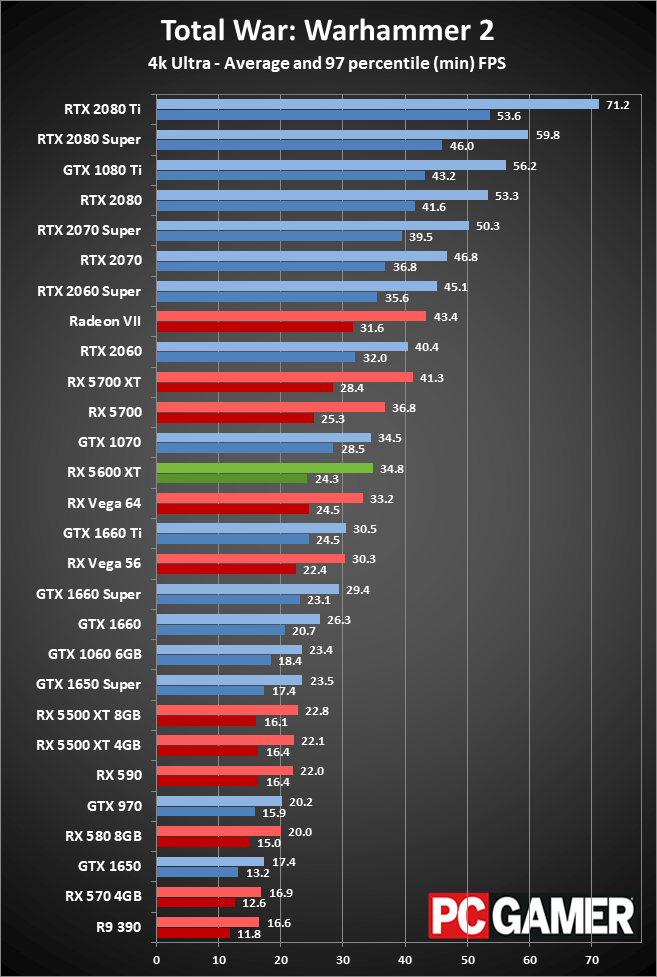
AMD isn't marketing the RX 5600 XT as a 1440p or 4K card, though it can handle some games at those settings. At 1440p ultra, the 5600 XT closes the gap with the RTX 2060, but each GPU still claims individual wins in the various games. The lead over the GTX 1660 Ti and Super increases as well, while the RX 5700 lead also starts to grow. If you have a 1440p display, playing at medium or high settings should get 60 fps or more in quite a few games.
4K continues to widen the gap between the various GPUs, but none of the mainstream cards are really intended for 4K gaming. Unless you want console-esque framerates of 30-40 fps, I suppose, maybe with resolution upscaling to help performance. Dropping from ultra settings to high or even medium would also boost performance quite a bit. This is one of the things many people overlook when they think current consoles can do 4K while PCs can't: decent PCs can absolutely handle 4K, especially at reduced quality settings and with resolution upscaling.
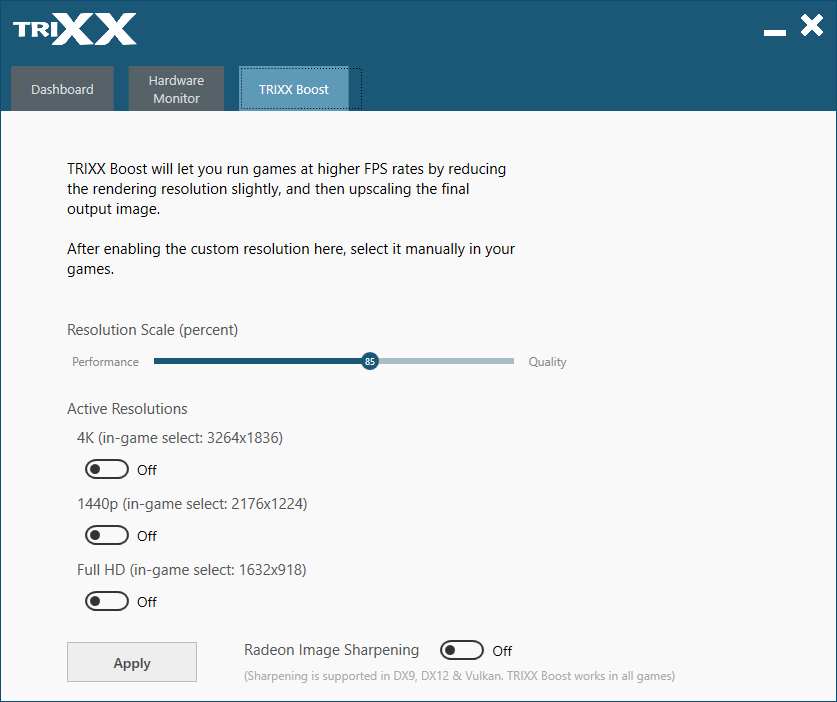
I'm not just saying that hypothetically, either. If you like the idea of the 4K console gaming experience, AMD has added a new feature to its latest 2020 edition drivers called Radeon Boost. It will dynamically lower the resolution of supported games, then upscale to your selected resolution. It's not a panacea, but it can certainly make games feel more fluid (at the cost of a bit of image quality) when enabled.
Sapphire's TriXX software also supports its own custom take on resolution scaling. Called TriXX Boost, it lets you choose lower resolutions for rendering and will then scale those up to the desired display resolution. You can also use Radeon Image Sharpening to improve the resulting image quality. Again, it's not perfect, but rendering 15-30 percent fewer pixels at 1440p or 4K can do wonders for framerates.
Radeon RX 5600 XT overclocking
I haven't fully investigated overclocking potential on the RX 5600 XT, but it seems to behave similarly to other Navi GPUs. The 'performance' VBIOS update did boost performance about 10 percent compared to the original 'reference' clocks, but that also likely means less headroom for additional overclocking. Less, but with some tuning you can get quite a bit of additional performance out of the GPU.
If you're willing to increase the fan curve to improve cooling, getting another 10 percent or so out of the GPU clocks shouldn't be too difficult, with enough perseverance. One of the big limitations with overclocking AMD GPUs is the default power tables, but it's possible to bypass (or at least alter) those, opening the door for clockspeeds up to 2.0GHz or more. Just keep an eye on temperatures to ensure the GPU doesn't overheat if you go that route.
You can also use AMD's own Radeon Software to tune your GPU settings (under the Performance tab now). Without additional tools, however, you'll hit artificial performance limits. Igor's Lab offers the MorePowerTool to overcome those limitations, though I wouldn't recommend it for inexperienced overclockers. You've been warned.

AMD Radeon RX 5600 XT value
The Radeon RX 5600 XT performs well, and is certainly worth considering, but is it a good value? Calculating 'value' isn't an exact science. There are many factors to consider. What resolution and settings do you want to use? What GPU do you have right now, how much will it cost to upgrade, or are you building a new gaming PC from scratch? If it's the latter, you're usually much better off spending more on the GPU. If you're looking to upgrade, on the other hand, I always caution that you should only upgrade when your current hardware isn't sufficient for the games and settings you want to play. Assuming that's the case, well…






For just the graphics card, the RX 5600 XT is a decent value—better than some cards, not as good as others. It varies by regional pricing as well, not to mention any sales you might find, but for the level of performance you get the RX 5600 XT is a great option, generally coming in just ahead of the RX 5700 and RTX 2060.
Those putting together a complete mid-range gaming PC (around $650, not counting the graphics card) should think about spending a bit more. The RX 5700 XT ends up sweeping the top spot in all three regions for FPS per money spent on the entire PC, with the RX 5700, RTX 2070 Super, and RTX 2070 also placing high on the charts. And again, this is based purely on performance and price—features like ray tracing support aren't a factor.

AMD Radeon RX 5600 XT: a tight squeeze for the $280 price point
AMD continues to fill in the gaps in its RX 5000 series line of graphics cards, with the RX 5600 XT landing awfully close to the RX 5700 in both price and performance. It's a good card, but is it better than the alternatives? Checking out the competition, there are several ways to look at things.
First, the RX 5600 XT easily beats the GTX 1660 Ti, leading by 17 percent at 1080p on average. Considering both the 1660 Ti and 5600 XT have similar features—there's no hardware ray tracing support on the 1660 Ti—at similar prices the RX 5600 XT is the clear winner. The GTX 1660 Super is slightly slower than the 1660 Ti, with a lower price as well. It's at best a tie with the RX 5600 XT, and I'd give AMD the win.
What about the RTX 2060? This is a harder one to call, because availability and pricing of the RTX 2060 are in flux, and all we have to go on is the official RX 5600 XT launch price. Performance is mostly a tie, with Nvidia having a very slight edge based on my testing—look at the games you want to play, though, as each GPU has several wins and losses. There's some personal opinion here, but I'd go for the Nvidia card, just because there are enough ray tracing enabled games now that my fomo kicks in if I don't have a card that supports that feature.

As I noted in the intro, things haven't fully settled down with GPU prices, so keep an eye on out for sales and price cuts. At the current price, the RX 5600 XT isn't a must buy, but it's worth a look for 1080p gamers that want to save a bit of money compared to other alternatives. Given the RX 5600 XT and RX 5700 both share the same core GPU specs, just with different amounts of VRAM, I do wonder if they'll both stick around long-term. Phasing out the 5700 and just keeping the 5600 XT and 5700 XT wouldn't be a bad idea. Then again, Nvidia still has 10 different Turing based GPUs (plus two 'discontinued' parts that are still being sold). The more the merrier, I guess.
There's another aspect of the RX 5600 XT that also hasn't 'settled down,' however, and it's that updated VBIOS. Any cards selling today can't possibly have the new VBIOS on them, as it was only released last week. I personally don't have a problem flashing the VBIOS on a GPU—I've done it countless times over the years. But people less versed in PC hardware, without a spare GPU in case things go wrong? Yeah, that's not great. And will all the initial RX 5600 XT cards get the same 10 percent boost I saw on the Sapphire Pulse? Definitely not. If you're planning on picking up an RX 5600 XT, then, be careful. It's not a long-term problem, but the first wave of cards may not perform as expected without a VBIOS update.
My biggest complaint with the RX 5600 XT is something AMD has struggled with repeatedly over the past several years: timeliness. A year ago, this would have been an amazing GPU, and it could have provided Nvidia's RTX 20-series cards with some much needed competition. 12 months later, it's no surprise that Nvidia is able to steal some of AMD's thunder by cutting the price on the RTX 2060. Even if AMD was trying to bait Nvidia into showing its hand with the early announcement of specs, only to sort of change things by launching with significantly faster factory overclocked cards, the fact is Nvidia's RTX 2060 is still a competitive card, despite having launched almost precisely one year ago.
When exactly will Nvidia's next generation Ampere GPUs arrive? No one can say for certain, but this year is pretty much a given. AMD's Navi GPUs are definitely more competitive than the previous generation Polaris and Vega GPUs, but I haven't seen AMD claim an outright win in the graphics card arena in the past decade. It would be awesome to see AMD not just challenge, but actually take down Nvidia's RTX 2080 Ti. Unfortunately, it's going to take quite a bit more than Navi 10 to do that.
The Radeon RX 5600 XT nearly matches the RX 5700 in performance, for about $50 less. It's competitive enough that Nvidia dropped the pricing of its RTX 2060 Founders Edition.
Jarred's love of computers dates back to the dark ages when his dad brought home a DOS 2.3 PC and he left his C-64 behind. He eventually built his first custom PC in 1990 with a 286 12MHz, only to discover it was already woefully outdated when Wing Commander was released a few months later. He holds a BS in Computer Science from Brigham Young University and has been working as a tech journalist since 2004, writing for AnandTech, Maximum PC, and PC Gamer. From the first S3 Virge '3D decelerators' to today's GPUs, Jarred keeps up with all the latest graphics trends and is the one to ask about game performance.



